

| Trade log-in: | HERE | |
| Get password | Forgot password | ||

2015.3 | 2015.2 | 2015.1
2014.3 | 2014.2 | 2014.1 | 2013.3 | 2013.2 | 2013.1 | 2012.3 | 2012.2 | 2012.1
2011.3 | 2011.2 | 2011.1 | 2010.3 | 2010.2 | 2010.1 | 2009.3 | 2009.2 | 2009.1
2008.3 | 2008.2 | 2008.1 | 2007.3 | 2007.2 | 2007.1 | 2006.3 | 2006.2 | 2006.1
2005 | 2004 | 2003 | 2002 | 2001 | 2000
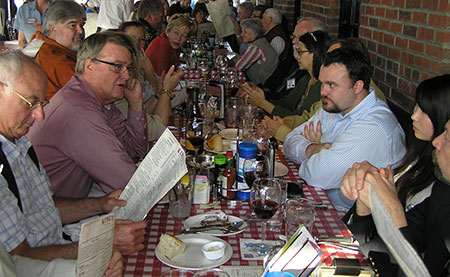 |
| Pala International’s Bill Larson talks in a relaxed atmosphere following his presentation at the eleventh annual Sinkankas Symposium. To his right is gem crystal collector Jon Sigerman and to his left is co-presenter, Shane McClure of GIA. (Photo: Elise Skalwold) |
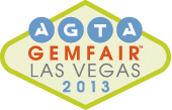 |
It’s time to plan for the JCK Las Vegas show. Pala International will be there in force, with one of America’s largest selections of fine colored gems.
Note: The JCK Show this year will run Friday through Monday.
When: May 30 – June 3, 2013
Where: South Pacific and Islander Ballrooms in the Mandalay Bay Convention Center, Las Vegas, NV
Hours: AGTA Gemstone Section
Thursday, May 30 thru Sunday, June 2:
9:30 AM – 6:00 PM
Monday, June 3: 9:30 AM – 4:00 PM
Booth: AGTA Pavilion, booth AGTA514
We look forward to seeing our many friends there. Visit the Pala International Show Schedule for future events. [back to top]
The eleventh annual Sinkankas Symposium was held on April 6 at the GIA World Headquarters and The Robert Mouawad Campus in Carlsbad, California. We received the following testimonial regarding the conference and thought we’d share it with you.
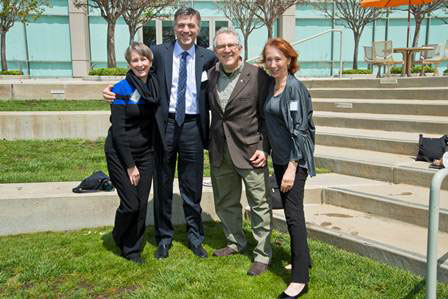 |
| Symposium attendees: (from left) Starla Turner, Richard Drucker, Patrick Ball and Suzanne Martinez. (Image © GIA) |
This was my first time attending the Sinkankas Symposium held at the GIA campus in Carlsbad. I decided to attend flying out from Chicago with no other purpose or business other than to attend the conference. I was thoroughly impressed. The single stone format, this time focusing on only ruby, offered attendees the opportunity to learn multiple aspects on this gem. We learned about sources, color, mineralogy, faceting, and even photographing rubies. There was something for the scientists as well as the collector. The photographs in the presentations and the conference book were spectacular. I commend Roger Merk and his staff of supporters for a fine one-day conference, well worth my attention and my attendance.
Richard B. Drucker, GG, FGA
President Gemworld International
Publisher of The GemGuide
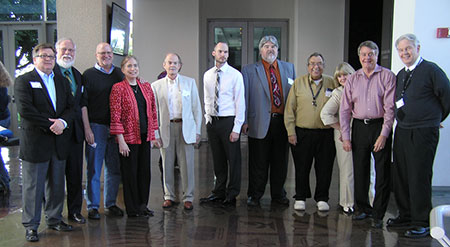 |
| Symposium presenters: (from left) Robert Weldon, Gary Bowersox, Richard Hughes, Elise Skalwold, Dr. George Harlow, Nathan Renfro, Shane McClure, symposium organizer Roger Merk, Jeanne and Bill Larson, Dr. James Shigley. Click to enlarge. (Photo courtesy Elise Skalwold) |
Richard told us that he will include an article about the symposium in the next edition of The GemGuide, which will be published May 1.
Check the symposium Publications page for the symposium proceedings, which will be made available shortly. [back to top]
If you’re planning to attend the ICA Congress next month, you’ll need to sign up for the post-conference tour by April 18. The tour, May 18–25, takes place in Hunan Province, beginning with a visit to the Yaogangxian mining area, then Shizhuyuan (one of the largest fluorite deposits in China, amongst other minerals), Xikuangshan (world’s largest antimony deposit), Chatian (luscious cinnabar), and more.
 |
| This Yaoganxian fluorite with quartz exhibits a nice complexity. Inventory #10067. (Photo: Jeff Scovil) |
Details are available in this virtual brochure. To sign up, email Seavy Chen immediately. [back to top]
Throughout history ruby and spinel have gone from being considered the same gem, to ruby’s great rise as a precious stone and spinel’s fall in association with synthetics, on through to ruby’s continued ascent as one of the earth’s rarest and spinel’s attempt to find itself amongst the elite gemstones.
Ruby, of course, was one of the original gem varietals recognized by the first collectors of jewels, even categorizing spinel as a ruby simply because of its red hue. The foundation and provenance of ruby is ingrained into modern adornment, while spinel has waited patiently for its rise. Spinel has exploded onto the gem radar over the last few years as one of the next great collectable gems. One dealer described this rise as the pricing/value gap shrinking between ruby and spinel, by means of spinel gaining ground on ruby’s dominance.
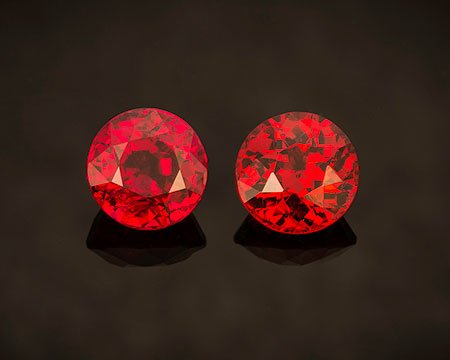 |
| Which is which? On the left, Inventory #19506. On the right, Inventory #20644. (Photo: Mia Dixon) |
Both have seen immense increases in value for larger, finer, completely natural varieties. In some cases it’s harder to source large red spinels than it is to find large rubies. The relationship between ruby and spinel runs deep and they continue to evolve together and separately in unique fashion.
Colors for ruby and spinel can overlap with a myriad of secondary hues, which give each stone a unique look. Fine ruby and spinel average in the range of 70–80% red and the remaining percentages can be filled in with pink, purple, orange or a mixer. Ruby still holds the most pure red the eye can perceive, in the “pigeon’s blood” realm, but in some cases spinel isn’t too far behind.
Interested? Select the inventory numbers above, call or email us to inquire. [back to top]
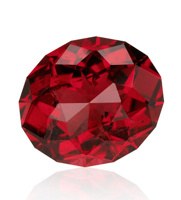 |
What do you do with an award-winning colored gemstone? In the case of Lisa Elser, recipient of a 2013 AGTA Spectrum award for a 14.24-carat Nigerian red tourmaline, you give it away. But not just to anyone. This gorgeous stone goes into the permanent collection of the Smithsonian Institution.
Lisa Elser – Custom Cut Gems, a firm based in Vancouver, is no stranger to giving. Elser and her husband Tom Schlegel buy rough material at the source, then donate a portion of their profits to support economic development in those same gem-producing countries.
Elser trained in cutting in Montreux, received her GG from GIA, and became a full-time faceter after years as a hobbyist, allowing her to retire from a career with Sun Microsystems. Schlegel, who engineered the tourmaline’s design, is a research mathematician, using his knowledge in gemstone creations. It was their work at Sun that originally took them to Southern Africa in 2000, and they fell in love with the region and its people.
For details on the couple’s “give-back” efforts, see this article from Coquitlam Now.
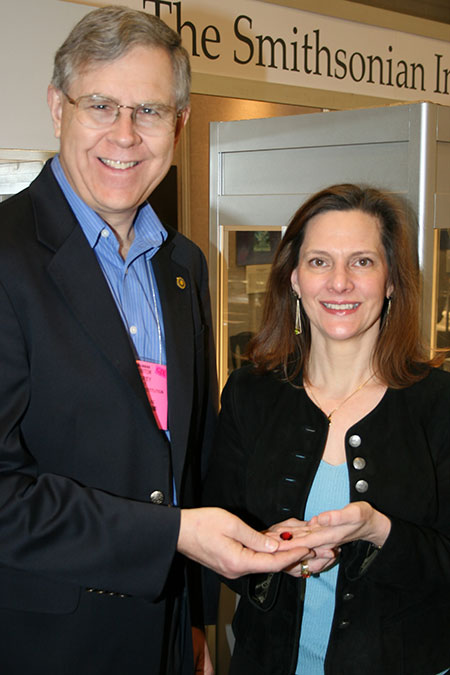 |
| ’Tis the gift to be free… Lisa Elser presents the tourmaline to Dr. Jeffrey Post, Curator of the National Gem and Mineral Collection during the 2013 AGTA GemFair in Tucson. (Photo courtesy Lisa Elser) |
[back to top]
 |
| This is a lovely 1.24-carat emerald treated with oil/resin. Ask for Inventory #596. (Photo: Wimon Manorotkul) |
The death of Victor Carranza marks the end of an era, the end of Colombia’s “emerald czar.” The story of Carranza’s dominance starts with prospecting near the Chivor mine, in central Colombia, as a young boy and discovering an emerald deposit of his own. He parlayed this entrepreneurial quest as he began to buy property and ultimately became one of the biggest land owners in the country, involved with the most famous emerald deposit on the planet—the Muzo Mine. Regarding his affinity toward the green jewels he said, “The emeralds follow me,” and he proved to have quite the innate sense of where they could be found, even spending time underground mining on the front lines.
During Carranza’s reign he had to wrestle with rival families, militias, and even the Medellín cocaine cartel, but somehow managed to hold his ground. Word in the emerald community is that possible successors to Carranza are not as well equipped to handle the power he amassed. Some of these characters are tough and not willing to negotiate. This could create a very volatile environment for the emerald trade in Colombia. We can only hope that some of the ruling families can explore some civilized means to sort out the power.
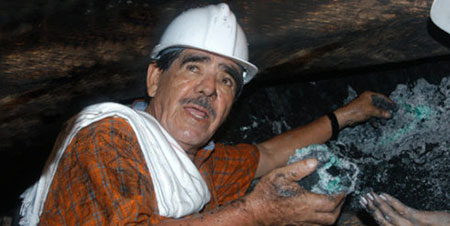 |
| ¡Que viva el Zar! In his reflections on the life and legacy of Victor Carranza, Ronald Ringsrud says Carranza gave the word guaquero (treasure digger) new meaning, as “he would direct tunnels and shafts to the richest zones, often personally working full shifts underground.” (Photo: El Tiempo) |
Emeralds have definitely seen substantial appreciation in the last few years along with most other gem varieties. The upper-echelon stones of rarity, size, and non-treated nature have seen the most dramatic increases. With this change in power of the main emerald conduit, we expect to see prices rise even more.
For more on Carranza, see our “Colombia 1 B.C.E.” from last July. [back to top]
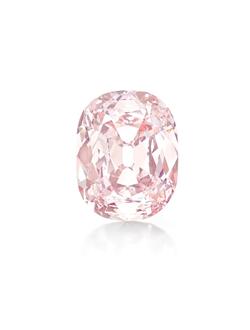 |
Christie’s New York announced yesterday the sale of a 34.65-carat Fancy Intense Pink diamond—the “Princie”—for $39,323,750. It hails from the Golconda mines of south central India, and is the most valuable diamond from that locality ever to be sold at auction. It also is the most valuable diamond ever sold by Christie’s.
The diamond was in the possession of the rulers of the princely state of Hyderabad (home to Golconda), and first was offered for sale at auction in 1960 by the Nizam of Hyderabad. It was purchased by Van Cleef & Arpels for what would today be $1.3 million. At a party in the firm’s Paris store, the diamond obtained its moniker in honor of the young Prince of Baroda (another princely state in India), who was in attendance with his mother, Maharani Sita Devi.
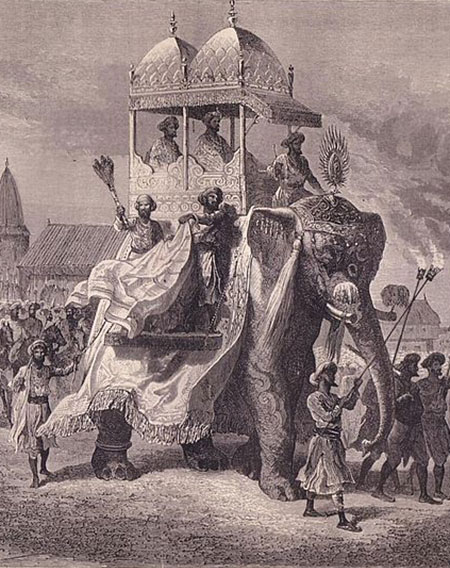 |
| Traveling in style. The Baroda king in a great procession, detail from an 1870s engraving. |
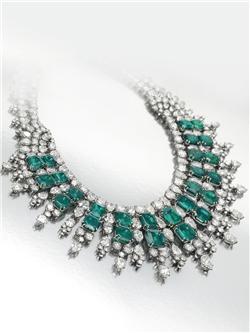 |
| Selling for just above its upper estimate, at $1,203,750, this Harry Winston emerald and diamond necklace was designed in the 1950s. (Photos: Christie’s press releases) |
[back to top]
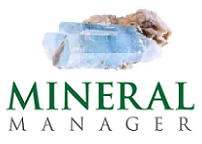 |
On Monday, Pala International’s Jason Stephenson was quoted in a press release regarding a new solution for gem and mineral businesses. Masterpiece Solutions, which for 18 years has served the fine art community, announced the development of a similar software and website product for our own needs. “We believe that Mineral Manager holds the keys to operating a successful gem or mineral business in today’s IT environment,” Jason said. “We’re excited that this software integrates all aspects of our business: contacts, marketing, inventory, billing, and our website presence.”
As Pala’s webmaster, I’m excited too. Thirteen years ago, my brother Richard W. Hughes, together with some local programmers, gave Pala its web presence, revolutionizing Pala’s inventory system in the process. Mineral Manager promises to provide us with v.2 in that evolution. Our current upload-to-web procedure requires a series of steps that often is hampered by a fickle (albeit T-1) Internet connection at Pala’s picturesque, but secluded, location. The procedure also uses an on-site database that can’t easily be accessed from afar. Mineral Manager, which is hosted on Amazon’s expansive and secure cloud, will allow us to, say, acquire a stunning spinel at the Tucson GemFair, take it to Jeff Scovil for imaging, and have it online within a matter of minutes or hours. And there’s no lag time between data entry and web publishing.
Mineral Manager will replicate our current components: inventory management, contact management, point of sale and client invoicing, mobile credit card payment processing, consignment payment processing and reporting, all with Mac (and PC) compatibility. But it also will replace our newsletter emailer, for which we pay a subscription fee, and it will replace our web hosting (a host we grudgingly went with when our original, local host was bought out). Mineral Manager offers website templates, blog (and such) integration, financial and contact reporting, and integration with QuickBooks. Collectors also will be interested in a 400-specimen version with special pricing. Visit Mineral Manager here.
— David Hughes, Webmaster and News Editor, Pala International
 |
| You can get a sense of how Mineral Manager will operate by viewing streaming videos on YouTube of its sibling, the gallery solution Masterpiece Manager. |
[back to top]
 |
| Rabbit’s blood. A fine natural red ruby from Kachin. Cushion cut, 1.73 carats. Inv. #21005. (Photo: Mia Dixon) |
Burma’s Ministry of Commerce estimated that the country’s jade “and other mineral resource” exports have dropped by $440 million over the last year, according to an Eleven Media Group story on March 31. The story gave statistics for the last few fiscal years, amongst other statistics that were just as conflicting or confusing as these:
Even as the Burma government had transported its troops into the jade land of Hpakant ahead of April 10 talks with Kachin Independence Organization reps, as reported by Kachin News Group, the talks were postponed. Democratic Voice of Burma wrote on April 9 that the decision was “mutual” due to time constraints. Apparently China, which also is slated to participate, objected to international observers.
Don’t know how we missed this one, but a recent story in The Myanmar Times mentioned a 2007 discovery of a unique artifact of international diplomacy—circa 1756! It’s a gold-leaf missive from Burma’s King Alaungpaya (1714–1760) to Britain’s George II (1683–1760) on a topic that’s almost irrelevant; it seems George couldn’t read the letter and had it sent to the library of his home town in Hanover, Germany, where it surfaced six years ago.
The letter is composed of gold leaf, 55 cm by 12 cm, with each side adorned by twelve cabochon rubies. Twelve lines in the Burmese language give permission to British merchants to remain on Hainggyi Island, with hopes that dealings between the two countries would improve.
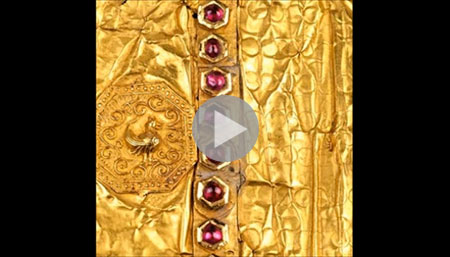 |
| Signed, sealed and delivered—and forwarded. See a two-minute streaming video providing background about the gold-leaf letter. |
Last fall, there was talk of a facsimile of the letter being provided to Burma’s National Museum. [back to top]
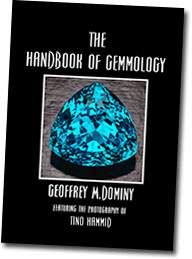 |
Vancouver-based Geoffrey Dominy has just released a digital-format book, The Handbook of Gemmology, featuring the photographs of notable photographer Tino Hammid. Why digital? “Tino and I chose to make our book digital for one reason and one reason only,” Dominy explains, “to make it affordable.” Indeed, a 650-page hardcover book would retail for $200 if not more. The digital format, for as little as $39.95, puts it in the hands of students, who can benefit from the information. As Dominy writes in his preface, during his own pre-Internet study for Gem-A courses, “I did find there were certain areas, namely crystallography and chemistry, that were somewhat lacking. … I was left at the mercy of the public library pulling my hair out trying to make sense of concepts that seemed beyond comprehension.” If only he’d had an e-book to study.
While we’re on the topic of the format, it bears explaining that such a format may not be for everyone. The book won’t render nicely on a laptop or tablet. Even on a 20-inch monitor, the default resolution leaves the text slightly distorted in the “.app” version we reviewed. (It also comes in three other formats; spend $10 more and get all four.) But then again, you don’t read two pages at a time, so simply tap the middle of a page to enlarge it. And you can enlarge quite a bit before images become pixelated—something you can’t do as easily with a hard-copy book—allowing for nice detail in the illustrations. You can mark up your virtual book with notes and highlights, something you’d be loath to do with a $200 book. And, of course, there is virtual bookmarking and—most useful—searchability (in addition to a traditional index that unfortunately is not hyperlinked to targets, but is printable).
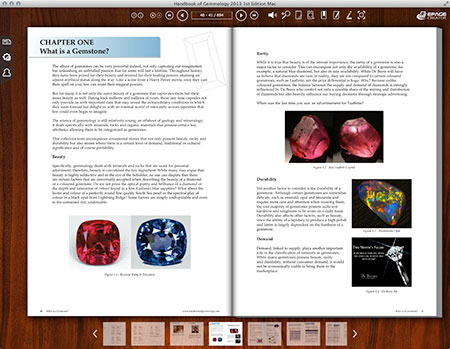 |
| A typical spread. Navigation and such are handled by controls at the top and bottom of the window, settings at the left side. Below, the same page is bookmarked (green), notated (yellow), and highlighted (violet). |
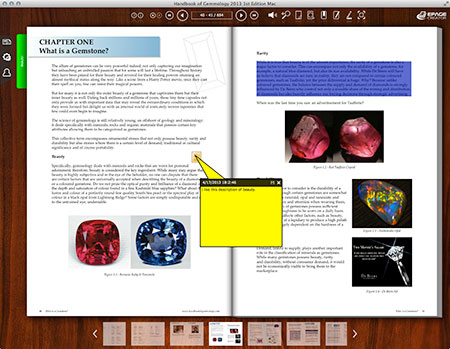 |
Moving on to the content, which begins with a basic question, “What is a Gemstone?” and differentiates a gemstone from a “mineral” and a “rock.” This is followed by a discussion of gemstones’ chemical nature, properties (physical, chemical, optical), and some basic crystallography.
Light is handled next, including absorption and spectroscopy; the 3 R’s (reflection, refraction, refractometer); polarized light and the polariscope; and pleochroism, the dichroscope and color filters. Specific gravity and luminescence are next.
Now, the first of several sections of eye candy (not that the other sections are short on lovely images), as part of a look at magnification (and thermal conductivity), which is followed by 24 illustrations of inclusions. Next, imitation and assembled stones are covered, followed by synthetics. (I know that this last chapter would have been useful in regard to our look at Dr. Karl Schmetzer et al.’s work on flux-grown alexandrites in February.) Again, this chapter is accompanied by many photomicrographs.
Treatments and enhancements are handled next, and include price modifiers. Gem mining covers both localities and techniques. Next is cutting and grading, including diamonds, with some beautiful photographs of jade by Tino Hammid. This is but an appetizer for a section devoted to 160 of his images, “Reflections by Tino Hammid.”
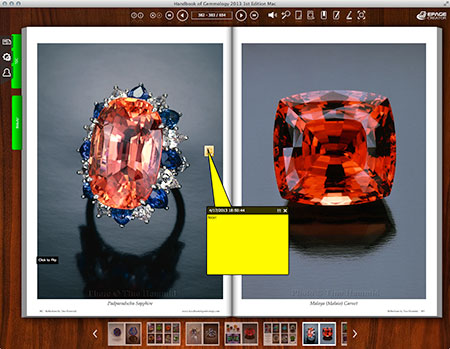 |
| From “Reflections”: A padparadscha sapphire at left, a Malaya garnet at right. You, of course, won’t have your view obstructed by the note we’ve included as a piracy deterrent. (Images © Tino Hammid) |
The book is rounded out by more than a dozen chapters on gemstone identification, mostly grouped by color, for one-stop shopping. Amongst these chapters are discussions of natural, cultured and imitation pearls as well as advanced gem testing techniques. Appended… are eleven appendices, including lists of gemstones by refractive index, specific gravity, etc., and some quick reference guides.
There’s an impressive amount of information provided by Geoff Dominy—all in one place and with ease of access. Such a book as this likely wouldn’t be read from cover to cover even as a traditional book, so the format seems perfect. It’s the sort of reference you’ll find yourself coming back to time and again in pursuit of answers to questions or clarification of terminology or science. One of the most exciting aspects of digital technology is its revisability, and Dominy is taking full advantage of this by offering the reader a new edition at a preferred price every year beginning in May 2014.
More information is available at the book website. [back to top]
— End April Newsletter • Published 4/17/13 —
Later this month you’ll want to begin watching “Prospectors,” the nine-part series that premieres March 26 on The Weather Channel.
It follows Colorado gem mining families in the state’s mountains. (A second season already is being contemplated.) The series, produced by High Noon Entertainment, had its genesis when the company’s Scott Feeley shot video for the Denver Museum of Nature and Science regarding its famous “Diane’s Pocket” aquamarine, found in the Sawatch Range. (See our “Record Aquamarine Specimen,” December 2006.) The locality in question, Colorado’s Mount Antero, features prime gem fields, as was mentioned in Sunday’s Denver Post. While High Noon has more than 25 shows in production, Feeley told the Post that “Prospectors” was shot in the “most extreme” location of their experience, filming at 13,000 feet. Weather, of course, also threatened to factor in. Streaming video attests to the challenges faced by the crew.
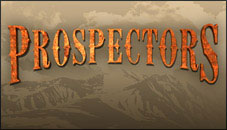
The annual Sinkankas Symposium has been described by John Koivula as the “best gem mineral symposium in North America” and has a reputation for achieving sold-out enrollment. Some coaxing in that direction was needed last year, however, when the symposium topic was Topaz.
This year’s topic of Ruby, however surely will send the scalpers scrambling. Keynote speaker Richard W. Hughes will introduce the assembled experts who will cover a wide range of related topics. Hughes, most recently, is the editor of The Book of Ruby & Sapphire: From an unpublished 1936 manuscript by Col. J. F. Halford-Watkins. His 1997 Ruby & Sapphire is considered the standard reference on the subject. Hughes’s presentation deals with the stones that caused an international crisis and to this day are off-limits: Mogok’s pigeon’s blood rubies.
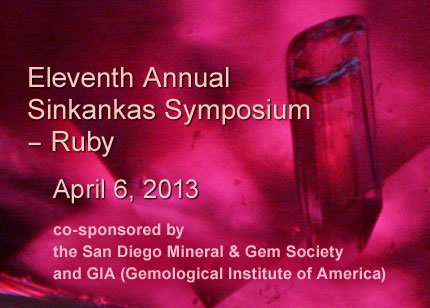 |
Since the time of our last newsletter, added to the lineup is Elise Skalwold, who will be familiar to our readers. Elise will speak on “Dr. Allen Bassett and the Ruby Mines of Nepal,” a preview of a forthcoming article by the same name.
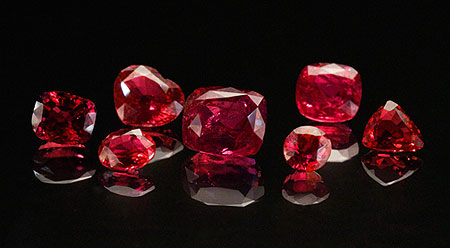 |
| Rubies from Winza, the Tanzania locality that wowed us into showcasing it as our featured stone in December 2008. (Photo: Mia Dixon) |
Visit the Sinkankas Symposium website for speaker bios and abstracts of presentation topics.
The Sinkankas Symposium is organized by Roger Merk, and co-sponsored by the San Diego Mineral & Gem Society and the GIA (Gemological Institute of America). It will be held Saturday, April 6, 2013, at the GIA World Headquarters and The Robert Mouawad Campus, 5345 Armada Drive, Carlsbad, CA 92008.
The registration form is posted on the Symposium web site. Join the San Diego Mineral & Gem Society mailing list to be kept informed; after submitting your email address, be sure to select the Sinkankas Symposium checkbox. [back to top]
Members of the Mineral Sciences staff of The Natural History Museum of Los Angeles County attended the Tucson shows and documented much of what they saw, featuring it on their MinBlog last month. (Be sure to see Parts 2 and 3 also.) As you browse, you’ll see some Pala people (and Pala pals)…
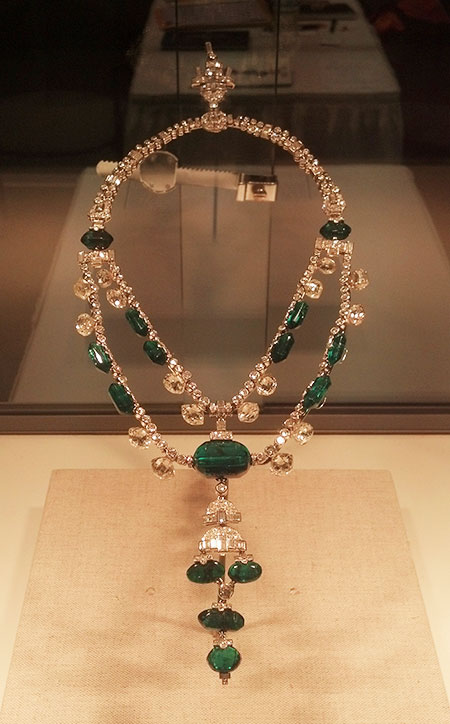 |
| Spanish Inquisition Necklace. This was displayed in the Smithsonian Institution display at the AGTA GemFair. Jeffrey Post, curator of the Smithsonian’s National Gem and Mineral Collection, described the piece in 2007. The name was given by Harry Winston. The necklace was owned by India’s maharajah of Indore. The large emeralds and diamonds were cut during the Mogol period in India (early 1600s)—the oldest diamonds in the Smithsonian’s collection. (Photo: Mia Dixon) |
As noted above, the Smithsonian Institution had its (un)usual presence at the GemFair. Not displayed, however, but featured in this month’s Smithsonian magazine, is the Dom Pedro Aquamarine. Curator Jeffrey Post called its size “unprecedented.” Originally part of a three-foot-long, 100-pound specimen, it was dropped by prospectors who found it in Minas Gerais, Brazil, in the 1980s. Only the largest piece was saved from jewelry cutting. In the 1990s it found its way into the workshop of German gem artist Bernd Munsteiner, who studied it for four months before spending six months on the carving. The Smithsonian display uses fiber-optic lenses and daylight-halogen bulbs to illuminate the 14-inch obelisk. See a complete photograph of the sculpture here. [back to top]
This month we feature some new purchases from the Tucson show.
The first feature is a tsavorite from Eastern Africa. This tsavorite is a step above the average, with an ideal medium tone and super saturation. So often tsavorite is overly dark in tone when you get into larger sizes. This one really is the Goldilocks of tsavorites…just the right color coming to us just at the right time as tsavorite has seen an uptick in demand. Tsavorites have a short history as a gem variety, only dating back to 1967 when the late Campbell Bridges discovered them in northern Tanzania. He later found them in southern Kenya in 1970, near Kenya’s Tsavo National Park, and coined the name tsavorite in 1974 along with Henry Platt of Tiffany & Co.
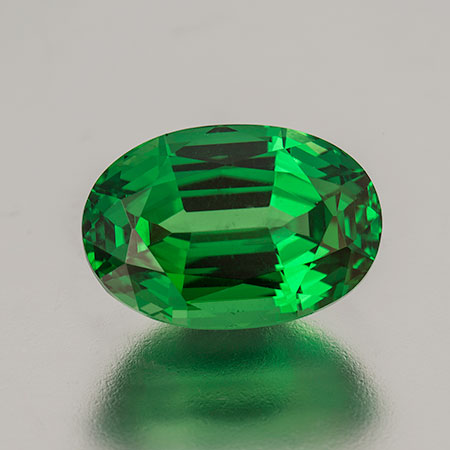 |
| Kenyan tsavorite, 10.94 x 7.36 x 5.69 mm, weighing 4.52 carats. Price available upon request. (Photo: Mia Dixon) |
This month’s second feature isn’t technically a faceted gem, but it certainly is a gem. We have seen rough diamond crystals popping up more and more in designer jewelry. These three unique gems would inspire design as well as entice the collector.
The first one is a 9.04-carat octahedron from The Democratic Republic of Congo. It displays perfect octahedral form with etched faces full of trigons and terraces. This crystal is a grayish white with no damage and good translucency. The second diamond is an unusual 7.8-carat double yellow macle from Russia, with an unusual Christmas tree-like formation from two penetrating macles. The top faces are like windows, looking into a fairly clean core with some internal crystals. This diamond is a light yellow, with no damage and very lustrous. The third is an extremely rare 3.44-carat white macle from Canada. It features perfect macle form with etched faces. The crystal is colorless and nearly flawless, showing great transparency. No damage; just a pristine jewel.
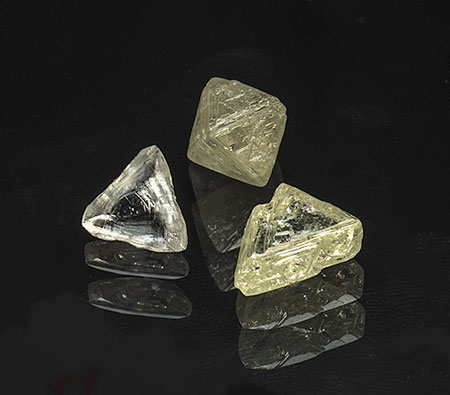 |
| Diamond Trio. See above for descriptions. Prices available upon request. (Photo: Mia Dixon) |
Interested? Call or email us to inquire.
[back to top]
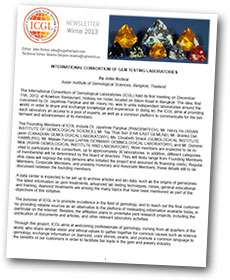 |
| The ICGL has issued its first newsletter. Topics include identification of yellow sapphire, identification of diamond for synthetic origin, and a look at the Mandalay jade market. |
Last month we received a notice from Dr. Jayshree Panjikar, of Pangem Testing Laboratory, about a new laboratory initiative that she has co-founded with six other labs. The International Consortium of Gem Testing Laboratories was established in December 2012 at the initiative of Dr. Panjikar and Henry Ho, of the Asian Institute of Gemological Sciences. They look forward to about thirty member labs from around the globe.
Aims of the organization, according to a press release, are: unification of independent labs worldwide, sharing of knowledge and experience, and providing access to a pool of experts as well as a common platform for communication. Plans include a data center to collect articles and lab data on gem treatments, advanced lab testing techniques, mines, education, and diamond treatments. Joint research projects will lead to publication efforts.
The other founding members of the consortium are Tay Thye Sun (Far East Gemlab), Branko Deljanin (Canadian Gemological Laboratory), Elisabeth Strack (Gemological Institute Hamburg), Masaki Furuya (Japan Germany Gemmological Laboratory), and Dominic Mok (Asian Gemological Institute and Laboratory). [back to top]
GIA announced on February 28 that its website and gemstone reports would get a makeover. Last week, the scheduled mid-March rollout hit a snag, due to security issues with the reports, which clients will be able to access securely online.
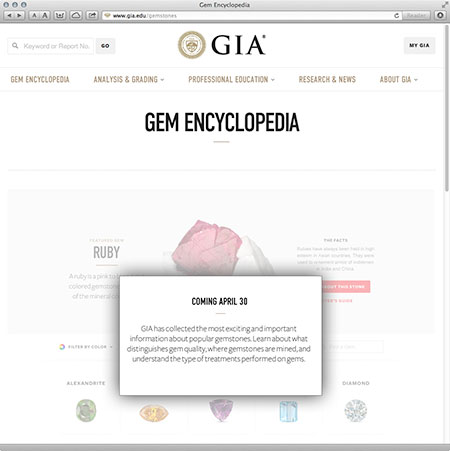 |
The website is to feature “photography from GIA’s unparalleled collection of historic and contemporary images of gems and jewelry” and “will deliver timely and engaging information for visitors of every interest level.” Archival information is to be added later in the spring. For instance, due to debut on April 30 are a Gem Encyclopedia as well as a Research & News section that will feature a desktop version of the journal Gems & Gemology.
The Laboratoire Français de Gemmologie (LFG) website, while in the French language, nevertheless has at least three items of interest to speakers of other languages, thanks to online translation options.
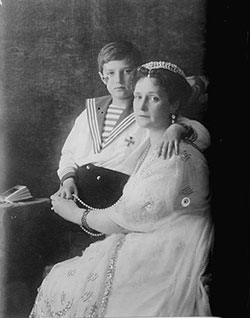 |
| Who is the mystery woman? (Photo: Bain News Service, Library of Congress) |
“Study of a ‘secret optical jewel’ to the LFG/ [P]hoto-microscopique jewel of René Dagron” is how Microsoft Translator rendered a title that originally appeared in the Revue de l’Association Française de Gemmologie (No. 180, June 2012).
Building upon the invention of microfilm by John Benjamin Dancer, René Dagron (1819–1900) obtained a patent in 1859 and a decade later published his 36-page tract (translated as) “Photomicroscopic cylinders mounted and non-mounted on jewels: Patents in France and abroad.” Dragon’s microfilms might have been considered only novelties if it weren’t for Prussia’s Siege of Paris (1870–1871). Carrier pigeons were employed to transport microfilm across the blockade.
The jewel that came to LFG is an ovoid gold pendant, 18.9 x 10.1 x 9.8 mm, weighing 1.96 g. Two openings in the pendant allow light to pass, revealing the tiny portrait of a woman. After research, the woman was identified and the provenance of the pendant was determined.
The two other articles of note on the LFG website are
 |
The Swiss Gemmological Institute SSEF has published its annual compendium of research and news, Facette No. 20.
The lead article, by Dr. Michael Krzemnicki, is “Kashmir Sapphire,” in which are discussed the Kashmir “brand” and the related issue of the importance of origin determination, inclusions (illustrated), and chemical and spectroscopic properties. Dr. Krzemnicki spends some time comparing the “classic” source of Kashmir against Madagascar, and the nomenclature such as “Kashmir-type,” which is being used in some reports.
The lab received a “too good to be true” blue sapphire for inspection: it turned out to be cubic zirconia. Also through the lab doors was a purported Paraiba tourmaline necklace: some beads were tourmaline and others were polycrystalline lepidolite—still others were lepidolite featuring tourmaline intergrowths. Other items of interest: dyed Ethiopian opal, a beautiful chrysoprase necklace, color-change zircon from Burma, and chemical vapor deposition (CVD) synthetic diamonds.
Several pages are devoted to pearls: an expedition to the Paspaley, Australia, production area; pearls from Micronesia; X-ray computed micro-tomography and radiocarbon dating of pearls; corroded pearls; and Keshi cultured pearls. Also covered are a pair of drop-shaped pearl earrings said to be a gift of the former Crown Prince Carol of Romania to his mistress Elena “Magda” Lupescu in the early 1920s, and a hollow natural pearl in the shape of a “mystic fish.”
The Australian Gemmologist, journal of the Gemmological Association of Australia, has released an index of its Volume 24, encompassing the January–March 2010 through October–December 2012 editions. [back to top]
In the spring of 1977, Channel Islands fisherman Bertie Cosheril caught something unexpected in one of his lobster pots: a calcified object thought to be a nineteenth century musket. After years of off-again-on-again research and diving expeditions, it was determined that the musket came from an unnamed ship that had been “cast away about Alderney” in November 1592. In the 1990s, The Alderney Maritime Trust was formed “to oversee the security, excavation, conservation, display and publication of the Alderney Elizabethan Wreck and its contents.”
One of the artifacts found in the wreckage is a cigarette-pack-sized crystal that has been studied for the last three years by researchers at the University of Rennes. The report of their study was published March 6 in the Proceedings of the Royal Society. The authors conclude that “Alderney-like crystals could really have been used as an accurate optical sun compass as an aid to ancient navigation, when the Sun was hidden by clouds or below the horizon.” Our readers will remember our discussion of this material in the context of Viking navigation as well as the Alderney wreck in 2011 (see “Midnight Sunstone”).
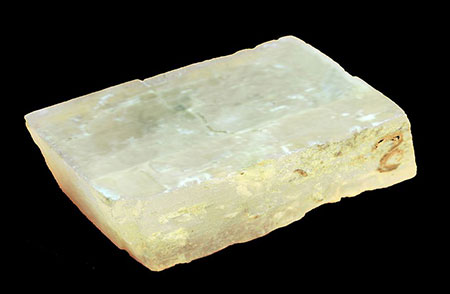 |
| The calcite in question. This photo was taken in Alderney, June 2012, and released on March 8, 2013, by Guy Ropars, coauthor of the new report. (Photo: Guy Ropars) |
The article abstract states that the relatively fragile calcite crystal was preserved by “two main phenomena, with opposite effects”:
We demonstrate that the Ca2+–Mg2+ ion exchanges in such a crystal immersed in sea water play a crucial role by limiting the solubility, strengthening the mechanical properties of the calcite, while the sand abrasion alters the crystal by inducing roughness of its surface.
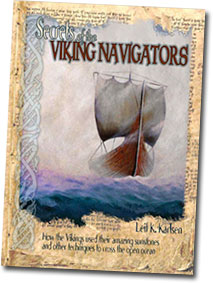 |
There are skeptics regarding the use of such crystals for navigation, such as Donna Heddle, director of the Center for Nordic Studies at the University of the Highlands and Islands in Scotland. Quoted in The Vancouver Sun, Heddle felt that such things should be found in Viking graves. However, as noted in The Independent, Viking warriors were cremated, causing any crystals to shatter.
We can direct skeptics to Leif K. Karlsen’s book, Secrets of the Viking Navigators, which discusses sunstone and other navigational techniques employed by Norsemen (and women). The book contains a postscript about the Alderney crystal find (pp. 174–176), which took place just prior to the book’s publication in 2003. Due to his work on the subject, the Europe-based Wreckshed Research Team contacted him to compare notes. The postscript contains two photographs of the crystal and a photo of Steve Wright, the diver who recovered it. [back to top]
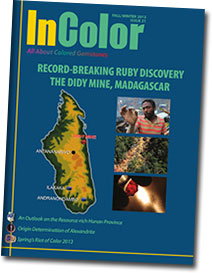 |
The Fall/Winter 2012 edition of InColor magazine has many articles of interest. One in particular focuses on efforts in Tanzania to benefit the communities surrounding the tanzanite mines of the Merelani Hills. The industry organization, Tanzanite Foundation, has built two local schools and supports another six, according to the article, “Tanzania: Ethical Initiatives and CSR Synergies.” As touted on the foundation’s website, the mining company TanzaniteOne pumps fresh water that serves 2000 villagers and 5000 cattle in the area surrounding the mines. A local orphanage provides education and housing to 400 children who have been orphaned or abandoned, largely by parents with AIDS. Local women last year were instructed by jewelry designer and carver Naomi Sarna in wire-wrap technique using lower-grade tanzanite, with the final product being sold in tourist shops.
 |
| An example of beautiful, natural tanzanite, 4.02 carats. Inventory #20497. (Photo: Mia Dixon) |
The foundation invited Sarna to the country to select a tanzanite crystal for carving, with the idea of it being sold to benefit the Masai people who live near the tanzanite mine. Because the government doesn’t allow rough larger than a gram to leave the country, the 200-gram crystal she selected (donated by the mine) was carved there. The result is a 725-carat carving (the largest ever in tanzanite), which will be sold.
Other articles you’ll want to see “Record-breaking Discovery of Ruby and Sapphire at the Didy Mine in Madagascar” by Dr. Adolf Peretti and Lawrence Hahn, “Origin Determination of Alexandrite – A Practical Example” by Dr. Karl Schmetzer and Thomas Hainschwang, “Hydrophane Opals: What’s the Weight?” by Olivier Segura and Emmanuel Fritsch, and “An Outlook on the Resource-rich Hunan Province” by Seavy Chen. [back to top]
In 1796, Napoleon Bonaparte presented an engagement ring to Josephine de Beauharnais, widow of Alexandre de Beauharnais, who was guillotined during the Reign of Terror during the French Revolution. Josephine might have met a similar fate but the Terror ended five days later. As a widow she had affairs, including with Napoleon, whom she met in 1795. They were engaged in January 1796 and married on March 9, just two days before he, as General of the French army, left for an invasion of Italy. Alone again, Josephine’s eye wandered, as did Napoleon’s. Eventually she would be crowned Empress by Napoleon himself, as captured in the famous painting by Jacques-Louis David. But Emporers need heirs, and Josephine (a mother of two with Alexandre) was found wanting.
Now, some 217 years after their marriage, the ring that Napolean gave Josephine is to be auctioned, along with a slew of other Napoleona, by Osenat in Fontainebleau. But it won’t be the centerpiece of the auction in terms of return. According to Osenat’s Jean-Christophe Chatagnier, Napolean was not wealthy. Chataignier told Agence France-Presse last month that Napolean’s lack of cash meant for a “very ordinary” ring. Chatagnier told Forbes over the weekend that the sapphire and diamond pear-shaped stones weigh approximately 1 carat each. More details on the March 24 sale are available at the Osenat website.
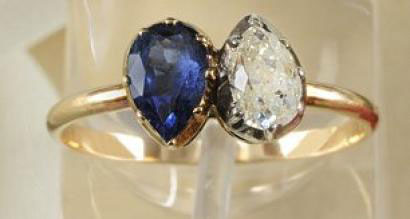 |
| Toi et moi: the name of the setting style of Napoleon’s engagement ring. (Photo courtesy Osenat) |
[back to top]
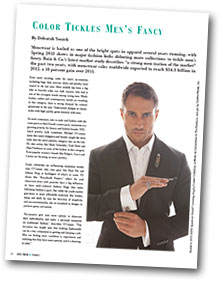 |
The current AGTA Prism magazine (Volume 1 2013) cites a Bain & Company market study that sees “a strong men-ization of the market” over the past two years. The story, by Deborah Yonick, states that the 2012 menswear sales worldwide would reach $34.3 billion, up 10% from 2011.
Colored gemstones are called for in the bracelet category, which is one of the hottest classes for younger men. New York jewelry style consultant Michael O’Connor credits actors like Brad Pitt and Johnny Depp, television shows like “Boardwalk Empire,” and men’s fashion blogs for raising consciousness. Affordable materials mean much, but simple, classic design for gems and metals also matter, he said. So cufflinks are back…
Yonick’s piece closes with a talk with what designers feel goes into a successful offering for the modern man. Read it here. [back to top]
 |
| Burma blue. A fine natural blue sapphire. Cushion cut, 1.26 carats. Inv. #20469. (Photo: Mia Dixon) |
Burma was slated to hold the country’s “first jewelry show organized by [the] private sector” on March 10, according to a short article March 3 by Eleven Media Group. It was to held at the office of Union of Myanmar Federation of Chambers of Commerce and Industry (UMFCCI) in Yangon.
The show was to cater to foreign customers and feature gems, jewelry, ornaments of jade and gold, and other items. “Myanmar famous model stars” also were to participate, but not famous enough, evidently, to be covered in the official New Light of Myanmar newspaper. (INSTORE magazine asked, cattily, “Other than Aung San Suu Kyi, who wears flowers instead of jewelry, does Myanmar even have stars?”)
Meanwhile dealers in Mandalay’s gem and jade market petitioned the government against a planned move of the market to Myinmu village in Amarapura, from the current location in Mahar Aung Myay township, a 1.5-hour commute. According to The Myanmar Times on February 25, the petition had received 2500 signatures in three days, out of an estimated 30–50,000 workers. U Than Htay, of the market’s social welfare group, claimed that the regional minister for forestry and mines, U Soe Myint, said the current venue looked like a vegetable market. The inference is that lower class sellers might be shoved aside in the prospective move. See more on the move in our November 2012 Burma Bits. Also see the newsletter of the International Consortium of Gemological Laboratories, above, for information about the Mandalay jade market.
Burma’s Central Statistical Organization website has been down for some time, but Eleven Media Group (EMG) reported that Burma trade statistics for the current fiscal year, which ends at the end of this month, show an upturn over the same period (Apr–Feb) last year. This comes despite a drop in jade exports.
The Burma government takes a hefty cut in legal sales of gems and jade. Enforcement is key, as was reported by EMG last week. From Nov–Feb of FY2012–13, the Border Trade Department collected 20.2 billion kyat ($2.5 million) for customs duty, compared with 5.3 billion kyat during the same period last year. This year seizures were made, whereas none were last year; the rate of seizure for jade and gems is less than on food and consumer goods.
“Profit sharing” is what the huge tax on jade and gems is referred to in a February 20 Myanmar Times story. Under that system, the state takes 40% “share” of jade and gem revenue (30% for other sectors) and tops it with a tax of three to five percent. Minister of Parliament for Shan State, U Nay Win Tun, wants a change, claiming that entrepreneurs are forced to file “invented tonnage of minerals extracted,” since they can’t recoup their production costs.
In other trade news, Burma’s Ministry of Mining announced it would issue new gem mining permits between February 18 and March 19 at 1 million kyat ($1,167) a pop, according to Mizzima News. The permit locations were to include Mogok.
Of course, new mining of Mogok ruby won’t mean much in the U.S., where the gemstone still is banned. Well, Burma’s government isn’t taking that anymore: the government is going to lobby for repeal of that legislation. An EMG story on March 8 quoted deputy minister for foreign affairs Zin Yaw as saying that Burma would take one step at a time to counter sanctions, on both a political and legal basis.
Indeed, sanctions now have become rather embarrassing given the fact that people like U.S. assistant secretary of state Jose Fernandez now are obligated to shake hands with people who are still on the blacklist.
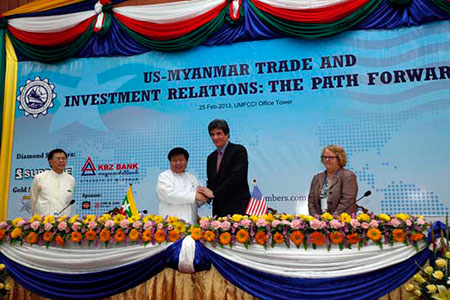 |
| Bedfellows. Jose Fernandez, right, shakes hands with Win Aung, president of the UMFCCI, at a February meeting with a 50-member U.S. business delegation. A memo of understanding was signed between the organization and the U.S. Chamber of Commerce, with the aim of promoting investment and economic cooperation between the two countries. Win took the opportunity to call on Washington to lift sanctions; technically, he is blacklisted himself. |
A Hong Kong auction of golden pearls from Burma was said to be a “positive sign” by Sean Turrell, a Macquarie University economic specialist on Burma told the South China Morning Post this month. Such a sale normally would occur in Burma, in secret, Turrell said; he cautioned, however, that it was “still a narrow one-off.”
The sale of the golden pearls, offered by the official Myanmar Pearl Enterprise (MPE), fetched 30% more in Hong Kong than would have been realized in Burma. The centerpiece of the sale, a 19-mm golden pearl dubbed the “New Dawn of Myanmar,” had a floor price of $4,300; it is said to have sold for $30,000 to $40,000. The sale was co-hosted by MPE and Belpearl (HK) Ltd., according to Jewellery News Asia, which reported later that 200 of 217 lots were sold, generally at 50% over the floor price. [back to top]
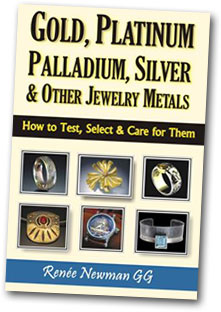 |
During the 2013 AGTA GemFair in Tucson, Renée Newmann’s twelfth book, Gold, Platinum, Palladium, Silver & Other Jewelry Metals, had its debut.
It is a great book filled with details to help you evaluate, test, buy, sell and care for precious metals and alternative jewelry metals such as titanium, bronze and stainless steel.
Renée always uses high-quality color photographs and does not disappoint yet again. Her way of writing makes it easy and fun to read.
She begins the book by discussing the history of different precious metals, accompanied by beautiful photography. She follows up by showing us different manufacturing methods that have been used throughout time, and weighing in on their advantages and disadvantages.
One section in the book discusses ways of testing a given metal to see if it is genuine or imitation; there are several methods you can do in your home with the help of simple tools.
This is a superb go-to book of great value to anybody in the market of buying or caring for their jewelry!
—Mia Dixon, Pala’s onsite photographer of gemstones and minerals
 |
| From the book. This gold leaf specimen comes from Breckenridge, Colorado. It features two vintage labels; one from the Collection of T. M. Phetteplace and the other from Lindstrom’s. It happens to be available via Palaminerals.com: Inventory #19391. (Photo: John McLean) |
Directors of the Sterling Hill Mining Museum last month renewed their $25,000 reward for a 2011 heist that decimated a collection that is valued at $750,000. (See our August 2011 story on Palaminerals.com.) According to a CBS New York story, the directors chose re-publicize the theft due to four other museum thefts in the past two years. [back to top]
With Pala Presents, we offer selections from the library of Pala International’s Bill Larson, who will share with us some of the wealth of information in the realm of minerals and mineralogy.
The present article, by George Frederick Kunz, on the variety of spodumene that later was to bear his name, was published in September 1903 in The American Journal of Science just after his shorter article, with the same title, appeared in the August 28 edition of Science. It was the latter article, as noted at the end of our earlier Pala Presents feature, “Spodumene from San Diego Co., California,” that Charles Baskerville referred to when he proposed, a week later in the pages of Science, that the variety of pink spodumene be named after Kunz.
While in the present article, “On a New Lilac-Colored Transparent Spodumene,” Kunz ends by stating, “If sufficient differences are found to exist between this spodumene and the other known varieties a new name will be given to it.” His editors at the Journal already were aware of the kunzite name: the only plate (X) accompanying the article labels the pictured specimens “Spodumene (Var Kunzite), Pala, California.”
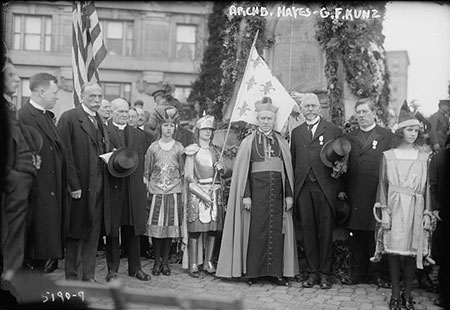 |
| Oh, the pageantry. George Frederick Kunz did get around. Here he stands next to Archbishop James Hayes, who at one time was a provincial superior of the Society of Jesus, the order of recently installed Pope Francis. To the cleric’s right, a Roman centurian (or perhaps an incongruous warrior-Marianne) holds a standard emblazoned with fleurs-de-lis, originally a religious symbol before it was adopted by French monarchy. Also present is Liberty adorned with the seven-rayed diadem, replacing the pilleus, the traditional felt cap of freed slaves. A third youngster sports a fur-trimmed smock (monogramed “RF”)—and pointed cap, itself a variation of the pilleus. (Photo: Bain News Service, Library of Congress) |
[back to top]
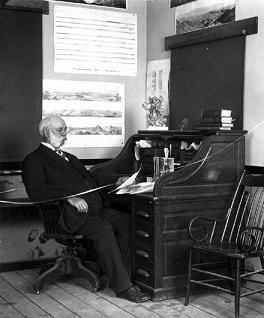 |
| Some mighty muttonchops. Gilbert Ellis Bailey at work. (Photo: Department of Geology, University of Southern California) |
According to his Los Angeles Times obituary, Gilbert Ellis Bailey (1852–1924) was dean of the geology department of the University of Southern California. His father, Gilbert Stephen Bailey, D.D., was chaplain of the Illinois legislature when Abraham Lincoln was a House member, and the younger Bailey was born in a house that stood across the street from Lincoln’s. He matriculated at the University of Chicago and did graduate work at the University of Michigan before teaching at the University of Nebraska. As State Chemist he made the first analysis of sugar beets in the U.S. He was territorial geologist for Wyoming and later president of the School of Mines in Rapid City. In the 1890s he moved to California and was dean at USC for the 25 years before his death.
While at USC, Bailey wrote the brief “California as a Gem State” for the Overland Monthly, a quaint magazine that took readers from the city into the American outback, with stories on everything from forest husbandry to California farmworkers. Amongst other material, in the article, Bailey describes in great detail the varieties of tourmaline found “on the Mesa Grande in the mountains east of San Diego.” [back to top]
— End March Newsletter • Published 3/19/13 —
The scientist does not study nature because it is useful; he studies it because he delights in it, and he delights in it because it is beautiful. If nature were not beautiful, it would not be worth knowing, and if nature were not worth knowing, life would not be worth living.
—Jules Henri Poincaré (1854–1912)
 |
| Pala in Madagascar? The sincerest form of flattery… (Photo: Brice Gobin) |
The annual Sinkankas Symposium has been described by John Koivula as the “best gem mineral symposium in North America” and has a reputation for achieving sold-out enrollment. Some coaxing in that direction was needed last year, however, when the symposium topic was Topaz.
This year’s topic of Ruby, however surely will send the scalpers scrambling. Keynote speaker Richard W. Hughes will introduce the assembled experts who will cover a wide range of related topics. Hughes, most recently, is the editor of The Book of Ruby & Sapphire: From an unpublished 1936 manuscript by Col. J. F. Halford-Watkins. His 1997 Ruby & Sapphire is considered the standard reference on the subject. Hughes’s presentation deals with the stones that caused an international crisis and to this day are off-limits: Mogok’s pigeon’s blood rubies.
 |
Regular Sinkankas Symposium contributor Dr. George Rossman, McMillan Professor of Mineralogy at Caltech, Pasadena, will discuss color in ruby and its relationship to the origin of color in the full range of various corundum gems. Pala International’s Bill Larson, no stranger to the Symposium dais, will present “Ruby Localities Shown in Brilliant Color,” drawing on over fifty years of traveling the globe in search of fine gems and minerals. Dr. George Harlow, Curator of Minerals and Gems in the Department of Earth & Planetary Sciences at the American Museum of Natural History, New York City, will discuss “Ruby from the Mogok Belt: Mineralogy and Geochemistry,” regarding the various processes affecting this unique locality. Distinguished Research Fellow at the GIA laboratory in Carlsbad, Dr. James E. Shigley returns to the Sinkankas Symposium for a third engagement, this time to discuss worldwide localities of ruby as well as the conditions and environments of its formation. GIA’s West Coast director of gem identification services, Shane F. McClure, will speak on “Enhancements to Rubies – both Natural and Synthetic,” an important topic in the gem trade. Nathan Renfro, who is Lead Analytical Specialist of colored stones at GIA as well as being a skilled lapidary artist, will present “Faceting Ruby: The implications for Optical Orientation on Color.” This year, Robert Weldon, Manager of Photography and Laboratory Publications at GIA, will present a personal historical narrative, “Trio of Ruby Tales,” illustrated with his beautiful photographic images.
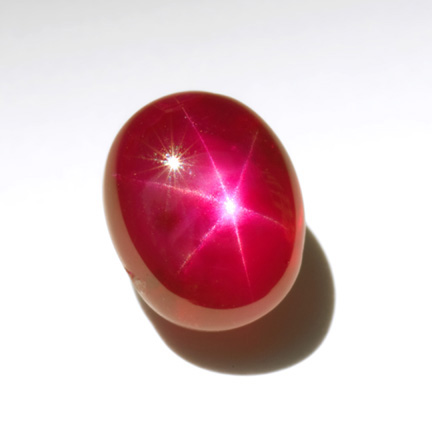 |
| Burmese star ruby, one of our featured stones for October 2009. From the Mogok Valley, this stone displays a pigeon’s-blood-red body color and a well-defined star. Inventory #16647, 5.18-carat oval cut, 9.82 x 7.92 x 5.87 mm. (Photo: Wimon Manorotkul) |
Visit the Sinkankas Symposium website for speaker bios and abstracts of presentation topics.
The Sinkankas Symposium is organized by Roger Merk, and co-sponsored by the San Diego Mineral & Gem Society and the GIA (Gemological Institute of America). It will be held Saturday, April 6, 2013, at the GIA World Headquarters and The Robert Mouawad Campus, 5345 Armada Drive, Carlsbad, CA 92008.
Invitations to pre-register will be emailed out to last year’s attendees in early March; registration will be open to ALL beginning in mid-March. Registration forms for all will be posted on the Symposium web site beginning in mid-March. Join the San Diego Mineral & Gem Society mailing list to be kept informed; after submitting your email address, be sure to select the Sinkankas Symposium checkbox. [back to top]
Capturing some of the action at Tucson…
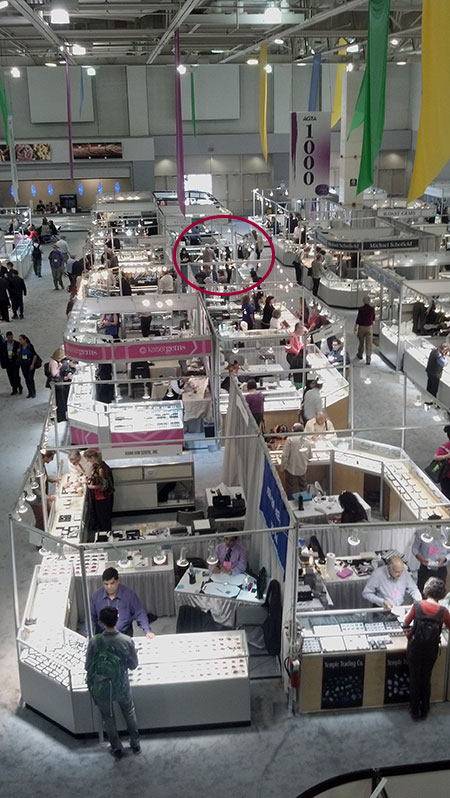 |
| On the floor. If you squint, you can spot the Pala International booth at the trade-only AGTA GemFair in Tucson last week. (Photo: Mia Dixon) |
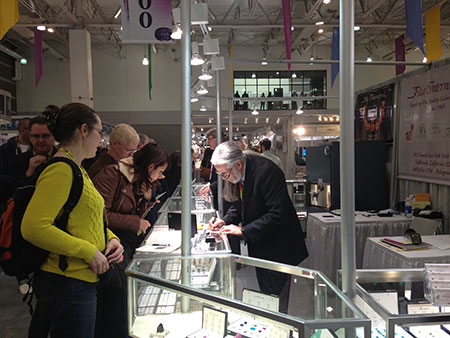 |
| That’ll be $omething.99… Pala’s Josh Hall (front), Bill Larson (with glasses, behind), and Jason Stephenson (with beard, at back) on a very busy Day 1 of the AGTA GemFair. (Photo: Will Larson) |
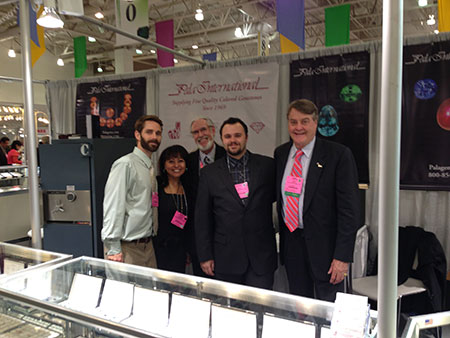 |
| In the pink. Members of the Pala crew step back from the counter long enough for a photo at the start of the GemFair. From left, Jason Stephenson, Gabrièl Mattice, Josh Hall, Will Larson and Bill Larson. |
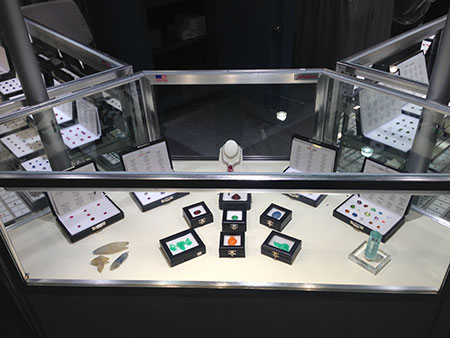 |
| Quite a spread. Two views of Pala offerings at the GemFair, including tempting crystals as well as faceted gemstones. Above, the centerpiece is our featured stone from last November, an 17.54-carat, GIA certified, imperial topaz from Brazil, in a platinum necklace set with 2.20 carats of diamonds. Click images to enlarge. (Photos: Will Larson) |
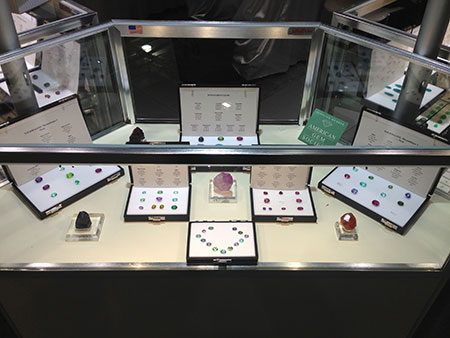 |
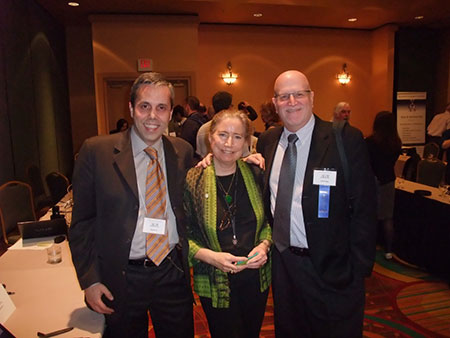 |
| Mingling. Pala’s special correspondent, gemologist and author Elise Skalwold, is flanked by gemologist, author and fifth-generation goldsmith Alberto Scarani, left, and gemologist, author and international playboy Richard Hughes. At the Accredited Gemologists Association conference, Scarani and business partner Mikko Åström demonstrated a new Raman/photoluminescence spectrometer, which had the dweebs a-drool. Hughes is keynoting this year’s Sinkankas Symposium. (Photo: Mikko Åström) |
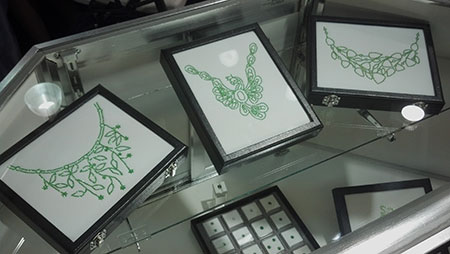 |
| Hmm… Someone has too much time on their hands. Click to enlarge. (Photo: Mia Dixon) |
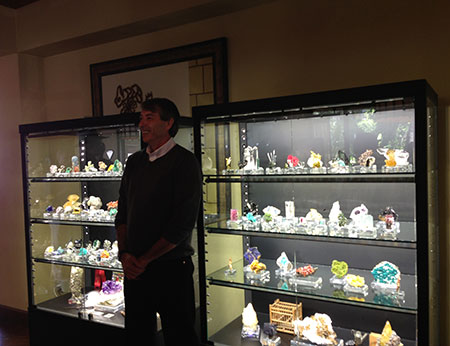 |
| Glitterati. On Saturday, Kevin Brown was featured on Collector’s Day. (Photo: Will Larson) |
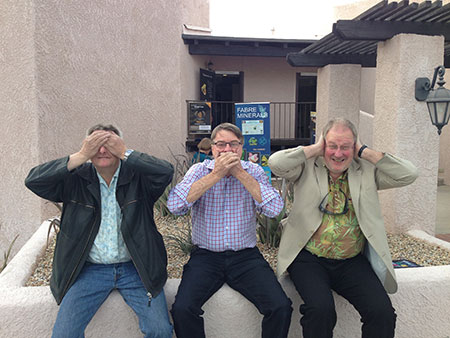 |
| Monkey business. Dealer Jean-Michel Laverrière, Bill Larson, and UPMC-La Sorbonne’s Jean-Claude Boulliard see, speak, and hear no evil. They promise. (Photo: Will Larson) |
[back to top]
This month’s featured stone, without a doubt, has to be red beryl. With the gemstone portion of the Tucson Gem and Mineral Show just having been completed, we found that red beryl was the most sought-after and asked-for stone of our show.
With only one recognized gem-producing locality—in the Wah Wah region of Utah—this bixbite variety of beryl is highly valued as a rare acquisition to gemstone collectors all over the world.
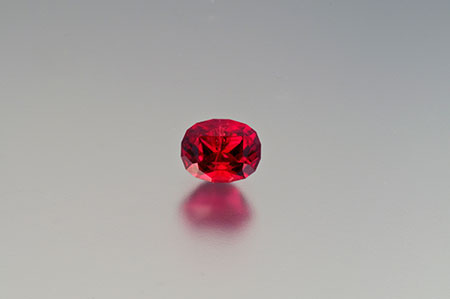 |
| Ruby Violet: ruby red. Red beryl from Wah Wah Mountains, Utah, 2.74 ct, 9.0 x 7.0 mm. Note that this particular stone has been sold. Click to enlarge. (Photo: Mia Dixon) |
In 1904, red beryl first was discovered at Topaz Cove, Juab County, Utah; the material mostly was not gemmy. Maynard Bixby was the head of this early mining project and in honor of Mr. Bixby, red beryl’s mineral name “bixbite” was conferred (not to be confused with bixbyite, also named for Bixby). This discovery was the beginning of what would prove to be one of the most important finds in U.S. gem mining history.
In 1958, gem-quality crystals were found 100 miles south of Juab County. It was in the Wah Wah Mountains of Beaver County that Lamar Hodges staked his claim. As a matter of fact, he had twelve claims that, throughout his mining career, were worked by him, various other family members and other sub-lease groups. These claims were known as the “Ruby Violet Claims.”
Although Hodges’s original desire was to prospect for uranium, he eventually deserted that plan, putting the Ruby Violet Claims project in its place. The discovery of gem-quality red beryl would launch this still relatively unknown variety of beryl on the road to legitimacy. This “red beryl” would forever stand in the “rare” category of “collection quality” gems and mineral specimens.
In 1967, the Rex Harris family would purchase the mining rights. The paltry amount of $8,000 seemed like a lot of money then. The mining started slowly, then mechanization eventually had to be established. Eventually the mine would be functioning at full capacity, producing upwards of 1,500 tons of material per year.
Rex’s daughter, Tina Nielson, states that the Harris family is in control of the only access and production available, and at present there is no material being commercially excavated for sale to the market due to negotiations in the works for the possible sale to a particular unnamed party.
At the Tucson show this year, it was lovely revisiting red beryl with our established clients and other enthusiastic trade members. It was fun to see how many visitors wanted to view the beautiful samples of ruby-like material, with selected pieces resembling lovely Burmese ruby with its pink secondary.
All of us at Pala love the rare and delicious, and take constant joy in sharing our knowledge and enthusiasm with all of you. Thank you for visiting us at Tucson and on the Web. With fond regards,

Gabrièl Mattice, G.G.
Fine Stone Acquisitions and Sales
Interested in other stones like this? Due to a limited amount of material on the market, we cannot promise that this will be available. Call (phone numbers below) or email us to inquire.
Peter Lyckberg was spotted promoting a labor of love that has occupied the last eight years by its author Peter Bancroft. The World of Gem & Crystal Treasures, co-authored Lyckberg, is a follow-up to Bancroft’s classic Gem and Crystal Treasures, which was published in 1984. Many new gem and specimen mines have come into production since that time, and the new book will bring readers up to date. The book is slated to feature contributions by Pala’s Josh Hall, Bill Larson, and Jason Stephenson, as well as Rob Lavinsky, Bryan Lees and Daniel Trinchillo.
These things don’t happen on their own, of course, and in the spirit of crowdfunding—or perhaps clusterfunding—sponsors are being offered the opportunity to contribute to the effort. Sponsors will receive leather-bound editions of the book, depending on level on contribution, and be acknowledged in the book. Contact Peter Lykberg for more information.
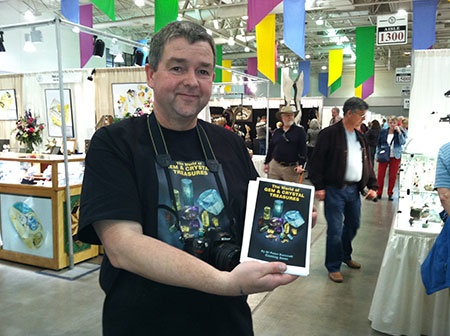 |
| Peter Lyckberg pounds the pavement in Tucson. (Photos: Elise Skalwold; Specimen Photo: Jeff Scovil) |
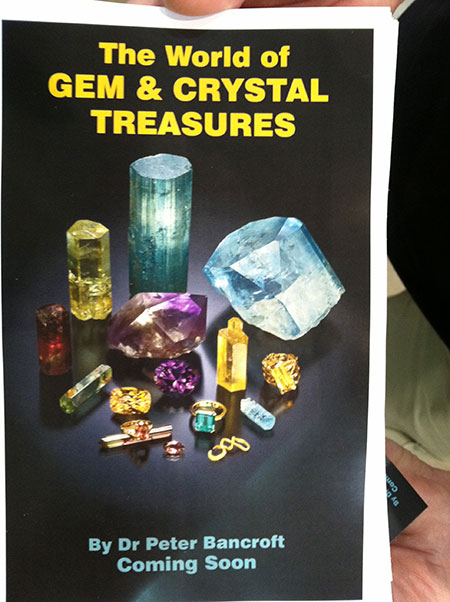 |
Bill Larson adapted his tribute to the late Edward Swoboda for the final all-color edition of The Pegmatite, the publication of the San Diego Mineral & Gem Society. Entitled “Ed Swoboda – Around the World in Eighty Years,” the article features the famous “Rabbit Ears” blue-cap photographed by Harold and Erica Van Pelt; it was Ed’s favorite specimen. You can obtain your own copy of the journal at the above link.
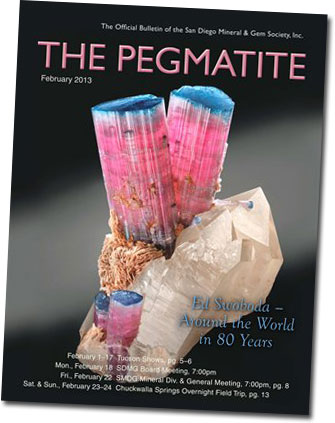 |
[back to top]
Back in the 20th century, beginning in the 1940s, Northern California reporters became fascinated with home-grown crystals of emerald and ruby by San Franciscan Carroll F. Chatham. The story goes that Chatham began “blowing up the family basement” at an early age, eventually turning to crystal cultivation in the garage, before receiving a degree in chemistry from Caltech in 1938. After accounts of his achievements in Gems & Minerals and Lapidary Journal in the late 1950s, Chatham finally hinted to The Denver Post in early 1960 that his success in emerald crystal growth “came from a lucky accident—I won’t say just what.” Indeed, in order to keep the process secret, Chatham never patented it, but the method is now known as the flux process. The Chatham website states that when Chatham left for Caltech in 1931, he left his crystal-growth experiment “running,” but his father cut the power, thereby providing an unwitting but key factor in the experiment’s success, and the beginning of a family business, as well as a name-game—cultured vs. recrystallized vs. processed (anything but synthetic)—that called upon the expertise of famed semanticist S. I. Hayakawa. (See the Chatham news archive for sources.)
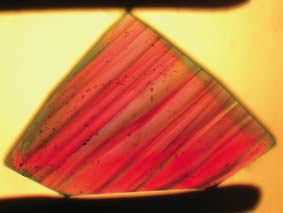 |
| Layered growth zoning associated with an intense colour zoning in a faceted synthetic alexandrite grown by Creative Crystals Inc.; immersion, field of view 5.3 × 4.0 mm. (Photo: Karl Schmetzer) |
In the 1970s, the flux process was applied to the growth of alexandrite by the forbears of Creative Crystals Inc., as is recounted in a new study of the material, “Flux-grown synthetic alexandrites from Creative Crystals Inc.,” by Dr. Karl Schmetzer, Dr. Heinz-Jürgen Bernhardt and Thomas Hainschwang in The Journal of Gemmology (33:1–4, 49–81).
The authors begin the study acknowledging flux growth of chrysoberyl in the mid 19th century. In the 20th century, “modern synthesis” of chrysoberyl and alexandrite (chromium-bearing chrysoberyl) began in the 1960s. Fluxes (e.g., a mixture of lithium-molybdate and molybdenum-oxide) were annealed (heated to high temperature) and allowed to cool slowly. The slow cooling rate is necessary to obtain clean or almost clean (i.e., gem quality) crystals.
While Chatham began marketing his emerald crystals in the 1950s, Creative Crystals Inc. (CCI) brought the first “commercially produced synthetic” alexandrites into the U.S. market in 1972. That same year, Richard Liddicoat wrote up the material in Gems & Gemology (14:4, 102–104), remarking on the hallmarks of flux synthesis as well as a “very attractive” appearance with a strong color change along the line of Russian alexandrites (as opposed to those of Sri Lanka).
Dr. Schmetzer and his coauthors also cite a 1974 description by Wilhelm Friedrich Eppler in the Journal of the German Gemmological Society (23:4, 286–293). Other than general overviews of synthetic gems as a group, no subsequent, detailed studies of the Creative Crystals material have been published. That’s not to say that none exists: Dr. Schmetzer et al. point to what was until now the most detailed study of faceted CCI alexandrites, a 1989 unpublished diploma thesis by Angelika Pohl on natural and synthetic alexandrite, which was performed at the University of Heidelberg. In fact, Dr. Schmetzer was able to examine the same material as Pohl in the late 1980s, and—at that time—a correlation of all observed properties, especially microscopic features, with a particular growth process wasn’t possible.
It was a challenge such as this that provided impetus to Dr. Schmetzer and coauthors to revisit this material. Another challenge, perhaps the most relevant to gemologists and jewelers, is the fact that, while the hallmarks of flux growth—residual flux, metallic particles (from crucible walls)—are detected easily, their absence is problematic: “faceted samples above 10 ct without any diagnostic inclusions are available,” as are included samples that mimic the genuine article. Our readers will recall Susan M. Neider’s close-call with a flawless 2.54-carat alexandrite in a Tiffany setting that seemed—and was—too good to be true.
The more gemologically oriented of our readers will surely appreciate that the present study is the first to detail a gem material that was grown in a slow-cooling flux process in numerous growth cycles with the intention of bringing it to the commercial market. It builds upon Dr. Schmetzer’s experience studying natural alexandrites from different localities (see Schmetzer, K., 2010. Russian alexandrites. Schweizerbart Science Publishers, Stuttgart, Germany, 141 pp. Schmetzer, K., 2011. Measurement and interpretation of growth patterns in chrysoberyl, including alexandrite. Journal of Gemmology, 32:5–8, 129–144).
“Flux grown synthetic alexandrites from Creative Crystals Inc.” begins its experimental section with a description of the study samples, taken from several private and museum collections (e.g., GIA and Smithsonian collections) as well as that of CCI’s David Patterson, who provides a two-page sidebar describing the CCI flux-growth method. (The faceted alexandrites studied in the late 1980s were no longer available.) CCI used a seeding technique (immersion of a seed crystal in the flux solution), and three orientations were identified in the present study, as illustrated below. The study contains a detailed explanation of the seeding procedure, with diagrams and photomicrographs side-by-side to elucidate the text.
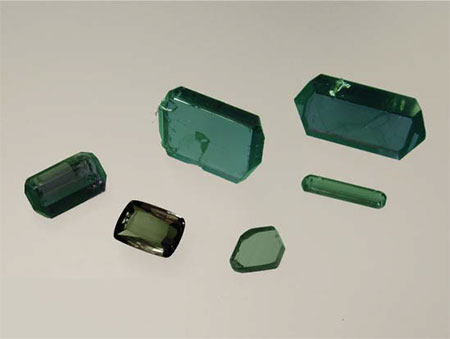 |
|
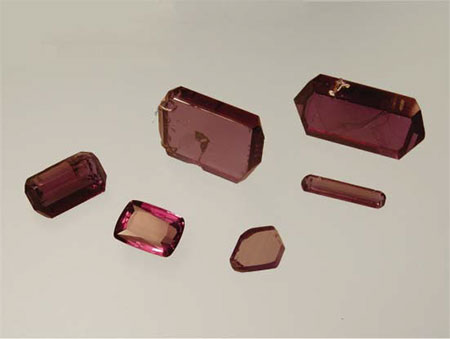 |
|
 |
Different types of rough and faceted synthetic alexandrites grown by Creative Crystals Inc. in daylight (top) and incandescent light; the crystals were grown on seeds parallel to the b pinacoid (1,2), parallel to the r prism (3,6) or parallel to the l dipyramid (4); the faceted alexandrite of 13.49 ct measuring 16.6 × 11.8 mm (5) was grown on a seed parallel to the r prism. (Photo: Karl Schmetzer) |
Prior to the presentation of details of the seeding technique, however, the study contains a description of the morphology of the sample material. Five of seven crystal faces observed are common in alexandrites in nature from various localities. The dipyramid l is another, larger face seen in the synthetic material, having been described in the literature only as an accessorial face in a single Sri Lankan twinned chrysoberyl, to the authors’ knowledge.
Next, microscopic growth features are covered for both crystals and faceted material. As one might expect, the seed orientation affects the internal growth patterns. Again, the study uses photomicrographs and diagrams to keep it understandable for the reader. Then, the study moves from growth zoning to color zoning—not unrelated, as three pages of excellent photomicrographs makes evident.
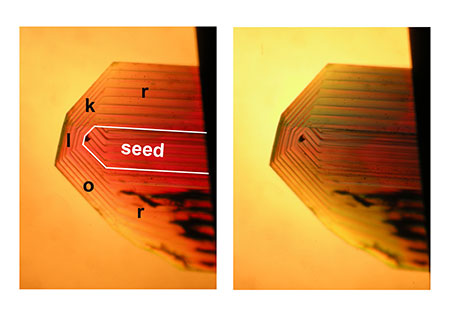 |
| Pleochroism and growth zoning, associated with colour zoning in r-grown synthetic alexandrite; the thick non-symmetrical synthetic alexandrite seed in the centre shows the same coloration and pleochroism as the main crystal; growth layers parallel to the faces r, o, l and k are indicated. Immersion, plane polarized light, field of view 9.5 × 7.2 mm. (Photos: Karl Schmetzer) |
Inclusions are handled next. Several photomicrographs display those common inclusions caused by residual flux, from the gossamer-like to the familiar oil-on-water-resist sort seen in flux-healed fractures in ruby. Less common are particles, needles and platelets of platinum (from the crucible). In one case, particles are trapped at the growth boundary. As alluded to above, the largest faceted sample studied was a 13.49-carat sample loaned from the Smithsonian Institution, containing none of these telltale clues.
The samples were subjected to several laboratory tests, including X-ray fluorescence (revealing remnants of flux), electron microprobe (revealing variations in element concentrations within different growth layers), a detailed examination of chemical zoning of a faceted stone by a microprobe scan of about 400 analysis points across a single alexandrite sample (illustrated below), absorption spectroscopy (using a specially prepared and oriented alexandrite cube), and infrared spectroscopy (revealing a need for further study to understand all observed features).
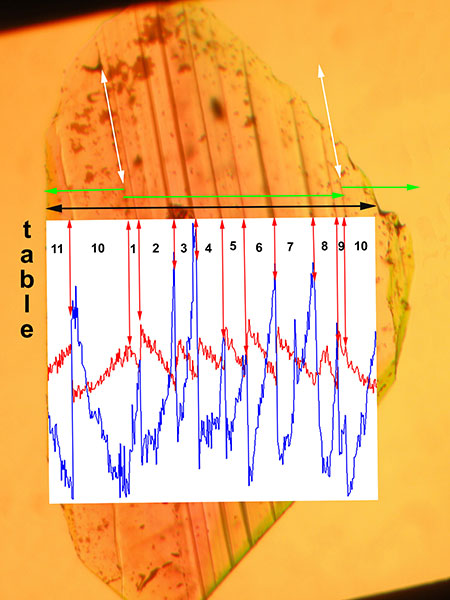 |
| The Cr and Fe trace element* contents are correlated with growth and colour zones in the alexandrite. This consists of a core with seven broader layers (labelled 2 to 8), two narrower layers (labelled 1 and 9) and an overgrowth of several layers on both sides of the core (labelled 10 and 11); the boundaries between the core and the layers of the overgrowth are indicated by white arrows; the growth directions of the different layers of the core and the layers of the overgrowth are indicated by green arrows. (Image: Karl Schmetzer) __________ *The inset shows plots of chromium (red) superimposed over iron (blue) concentration measured by an electron microscope scan, about 2.3 mm long, consisting of 402 analysis points (black arrow). |
The study is rounded out with a discussion of the consequences of the applied growth technology, i.e., the process of “growing” a layer a week. It’s a fascinating chemical journey towards a completed crystal. Finally, comparison of the Creative Crystals Inc. material with that of Russian flux-grown alexandrites is undertaken. It is an interesting contrast, because the Russian method does not employ seeding.
The thoroughness of this study places it easily beside Dr. Schmetzer’s monograph, Russian Alexandrites, along with his “Alexandrite and Color-Change Chrysoberyl from Lake Manyara, Tanzania,” as we noted a year ago, as well as with his 2011 examination of the “Novello Claims” alexandrite deposit in Zimbabwe. We look forward to his next offering. Oh, it’s already here: “Origin Determination of Alexandrite – A Practical Example,” in the Fall/Winter 2012 edition of InColor (Mac users are advised to view this in the Google Chrome browser). [back to top]
As fire is in stone,
as reflection in water,…
as silence in sound…
In “The Ownership of Words: An Essay on the Meaning of Padparadscha,” Richard W. Hughes begins by asking the obvious: Why is the term applied at all? Padparadscha sapphire is, as Hughes explains, “a marriage between ruby and yellow sapphire.” But the term is a corruption of the Sanskrit/Singhalese padmaraga, or “lotus color”—i.e., pink tending toward red. Yes, you may find the odd exception, but “lotus color” does not conjure in the mind the subtle orangey-red that we associate with padparadscha.* And what about those associations, those assumptions? Hughes takes us through several references to the color, letting not-quite a hundred flowers bloom, but opening up the discussion nonetheless. Next, Hughes turns to what was to be a “tightening” of the color description, which leads to its own complications.
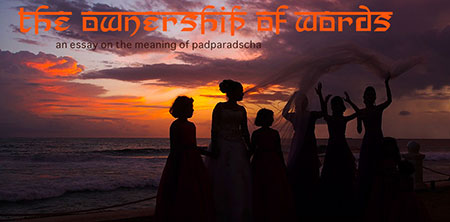 |
| The title image from Richard Hughes’s rumination on color; his muse, one of Nature’s elusive sirens. (Photo: Wimon Manorotkul) |
Hughes then examines archetypal padparadscha stones—gorgeously reproduced in his essay—against industry color-chips created to standardize what is admittedly a subjective exercise. We’d say, “Surprise!” but then you’ve come to expect that from the keyboard of Hughes.
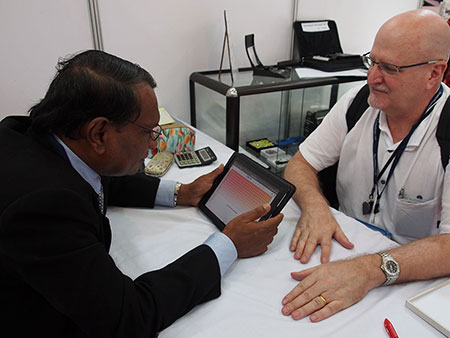 |
| Sri Lankan gem expert, Gamini Zoysa (left) taking the padparadscha survey as the author looks on. (Photo: Wimon Manorotkul) |
Finally, last summer, Hughes conducted a survey of nine colored stone dealers in Sri Lanka and Hong Kong to obtain a real-world frame of reference. Surprise again: no Sri Lankans were asked their opinion when the industry standard was codified, and they had their own ideas about the application of padparadscha.
All this and more in “The Ownership of Words.”
* Raga also is associated with passion or lust, which is fitting given that one must have a certain amount of ardor in order to obtain a padparadscha sapphire, a fine example of which can run in the tens of thousands of dollars—per carat. [back to text]
[back to top]
 |
| Spinelicious. This 8.07-carat natural spinel—one of the “spinel spectacle” we featured in October—would make a fine investment acquisition. Inv. #20439. (Photo: Mia Dixon) |
Myanmar Gems Enterprise (MGE) chair U Tay Za has submitted his resignation for the second time. The reason is not that his Htoo Trading Company’s strong ties with Burma’s military junta gives the industry a bad name (Tay Za remains on a U.S. sanctions list). Rather, in his December resignation letter, Tay Za wrote that he wished to devote time to “religious and social work,” as reported by The Irrawaddy on February 4. The tycoon also cited health issues: his first resignation request came in the wake of a helicopter crash in Kachin two years ago this month. An emergency meeting of the association on January 26 resulted in a request of Tay Za to remain in his post until 2014. An Upper House member, Hla Swe, was mentioned as being skeptical of the reasons for the resignation request, since sanctions remain an obstacle to development. (It was Hla Swe who proposed the “gem industry hub” in Parliament, which we referred to last month.)
The Myanmar Times, also reporting on the 4th on the same topic, discussed Burma’s goals for MGE, according to vice-chair U San Myo: “establishing a gems and jade value-added market in Myanmar, improving the production and trading sector, and setting up a specialised gems and jade laboratory.” While foreigners cannot invest in Burma’s minerals, they are welcome to participate in growing a value-added market, according to MGE secretary U Kyaw Htay. Plans are in the works for a duty-free gems and jade market in the political capital of Nay Pyi Taw, called Shwe Kyar Bin. (Eleven Media Group reported on the 9th that such markets also would be set up in Mandalay and Yangon. See below for more on this.) The lab is due to be completed later this year. We should note here that the candor with which The Myanmar Times reported this story stands in stark relief compared with a not-long-ago practice whereby the online journal was brought offline for breaches of de rigueur self-censorship.
Indeed, a junta-era anti-dissent order (No. 2/88, as in the 1988 pro-democracy protests of August) was repealed late last month, as reported by the official Myanma Ahlin newspaper, according to Associated Press. The order banned public gatherings of six or more people, but its enforcement apparently had been lax of late, according to a BBC story the week before. BBC profiled the two “Iron Ladies” of Burma’s northwestern Sagaing Region—farmers’ daughters Aye Net and Thwe Thwe Win—who have mobilized thousands against expansion of a China-funded copper mine, which they say is ruining crops due to what we’ll call acid drain, or water that drains through the mine’s tailings. Last Thursday, the activists demanded punishment for officials who were behind a November 29 crackdown at the mine that allegedly included use of white phosphorus shells, according to AP.
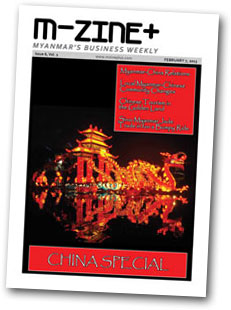 |
| The “ban” story originally appeared in the “China Special” edition of M-ZINE+ on February 7. |
Eleven Media Group (EMG) reported on February 14 that Burma’s 2013–14 National Planning Bill calls for an increase in gems production of 10.5%. An increase in jade production also is called for, but the amount is ambiguous, with 7% being cited in the lead paragraph, whereas the article body claims that a 7.8% increase is for “mineral[s] and jade.” The day before, EMG stated that jade, which was the second largest export “in the previous year” (which may refer to the 2012–13 fiscal year), “cannot be exported yet due to China’s heavy tax control.” A week before, Mizzima News reported on a “rumor” that the Burma government planned to
ban the export of raw jade stone starting sometime this year. It was part of an alleged scheme to have the country’s new capital become the go-to place for stone-cutting and polishing, giving a desired value-added element to a very important export commodity.
The Myanmar Times reported on January 28 that gem and mining products for the 2012–13 fiscal year likely will be down 15% compared with 2011–12. Unfortunately access to Burma’s Central Statistical Organization has been unavailable to us for the last month.
[back to top]
With Pala Presents, we offer selections from the library of Pala International’s Bill Larson, who will share with us some of the wealth of information in the realm of gems and gemology.
Sometime around the turn of the century, Tiffany & Co. published a slim volume on the subject of birthstones by its vice president, George Frederick Kunz. Natal Stones: Sentiments and Superstitions Associated with Precious Stones was perhaps a marketing ploy more than a work of scholarship. (Kunz would handle the latter in his Curious Lore of Precious Stones, in 1913.) In any case, the book was popular with the masses. It went into many editions (according to Library of Congress), enlarging from 30 pages in 1902 (the ninth edition) to as many as 40 in the 1920s (the twenty-sixth).
The book provides list after list after list. If, say, you remember ruby as December’s gemstone, but have forgotten the month’s guardian angel, special apostle, or flower, look no further. And now I understand the root of my marital problems (let’s forget for the moment that I’m tapping away at this on Valentine’s D—er—Night): lo these 19 years (we commemorate our nuptials on Wednesday) I’ve forgotten to wear my month’s natal stone, carnelian, thus affording me “No conjugal felicity.” —David Hughes
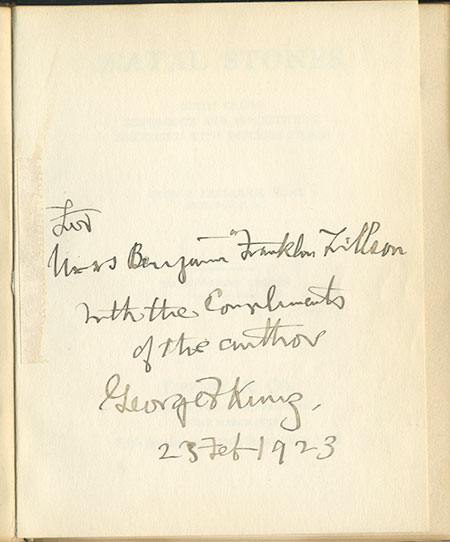 |
| The copy in Bill Larson’s library is dedicated to “Mrs. Benjamin Franklin [Florence R.] Tillson.” In 1938, Mr. Tillson would author Mine Plant, on the design of mines, published by the American Institute of Mining, Metallurgical and Petroleum Engineers. |
[back to top]
— End February Newsletter • Published 2/18/13 —
In this edition of our newsletter we remember Ed Swoboda.
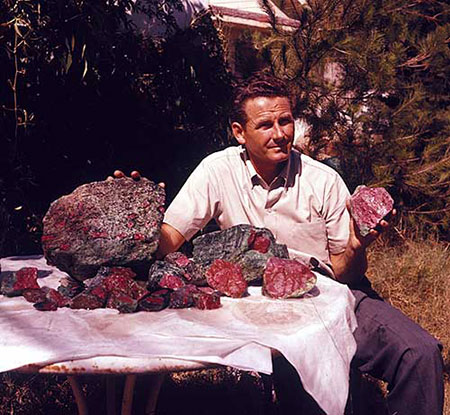 |
After the holidays, we’re looking forward to the world’s greatest gem and mineral show in February. One-stop general information about individual shows can be obtained from the Tucson EZ-Guide.
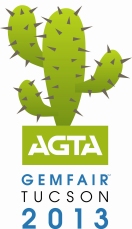 |
Pala International will be represented in Tucson as follows. We look forward to seeing our many friends there. Visit the Pala International Show Schedule for future events.
Pala joins nearly 100 exhibitors for this annual extravaganza.
Event: AGTA GemFair
When: February 5–10, 2013
Where: Tucson Convention Center
Pala International Booth: 1016
The event website now features an interactive floorplan allowing you to see who is exhibiting by area of the convention center.
More than forty free seminars are offered by notables in the world of gemstones and pearls.
Pala International’s Bill Larson will speak on the topic “Back to Burma” on Wednesday, February 6, from 1:00 to 2:00 p.m. in the Mohave Room.
Pala International and two dozen other world-class mineral dealers shack up at a Sonoran Desert resort.
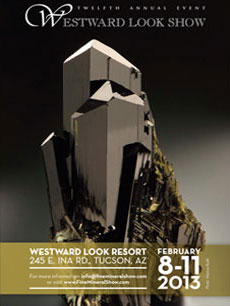 |
Event: 12th Annual Westward Look Mineral Show
When: February 8–11, 2013
Where: Westward Look Resort
Pala International Suite: 224
See Pala International’s page on the Westward Look Show site. See also this dealer map.
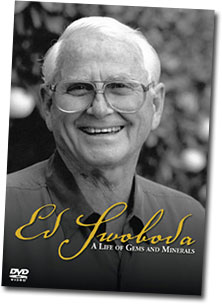 |
| The late Ed Swoboda was last year’s Sunday evening presenter. The event was captured by BlueCap Productions. |
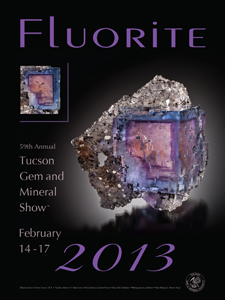 |
TGMS is the largest gem and mineral show in the country. This year’s theme is “Fluorite, Colors of the Rainbow.”
Event: 59th Annual Tucson Gem and Mineral Show
When: February 14–17, 2013
Where: Tucson Convention Center
Pala International Booth: Aisle 5 East
[back to top]
Many shows will offer their own shuttles. View your transit and parking options here. [back to top]
On December 1, 2012, after years of planning and construction, the Perot Museum of Nature and Science opened to the public. On January 8, 2013, despite sold-out crowds at the museum, Pala’s Bill Larson was able to take in the museum, providing us with this report.
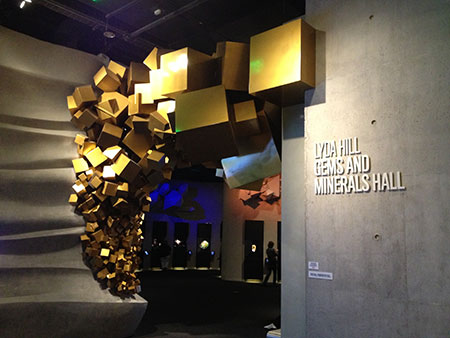 |
| Above, the entrance to the hall. Below, a display of beryls. (Photos: Bill Larson) |
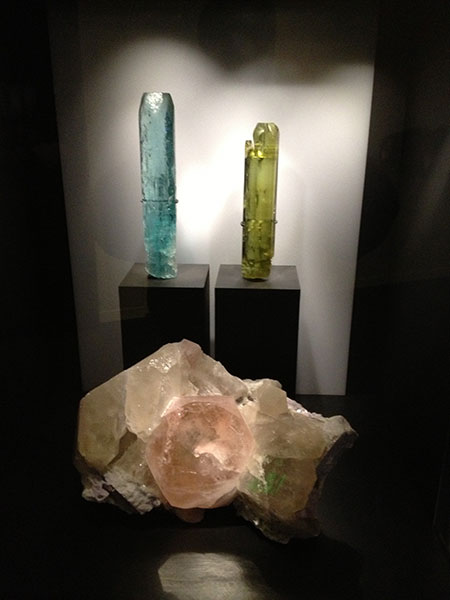 |
The museum contains eleven permanent exhibit halls and one traveling exhibition hall on five levels. Its most visually outstanding architectural feature is a 54-foot escalator enclosed in a 150-foot glass tube-like structure. [back to top]
The Gem & Mineral Council of the Natural History Museum Los Angeles County will present a members-and-their-guests exclusive reception in conjunction with a temporary display of five natural fancy vivid color heart-shaped diamonds in custom jewelry. The reception takes place Friday, February 1, 3 to 9 p.m., in the Mineral Science Office.
 |
Members can RSVP to Mary Stambaugh before January 29. Membership information is available here. [back to top]
During the holidays at the Denver Art Museum, we stumbled upon a modest exhibition that revealed itself to be as exquisite as, well, a Japanese lacquer box. Meticulously curated by Ronald Otsuka, “All That Glistens” (not the “All That Glitters” exhibition of colored gemstones presented in San Diego) demonstrates, in the course of only thirty pieces, the breadth of artistry in 100 years of lacquer work. Represented are not only the trays, containers and chests that usually come to mind, but also plaques, screens, and even braziers—imagine actually committing to utility such a one as the hand-warmer pictured below. Several of the pieces employ precious metals, mother-of-pearl, abalone shell, and other materials familiar to jewelers.
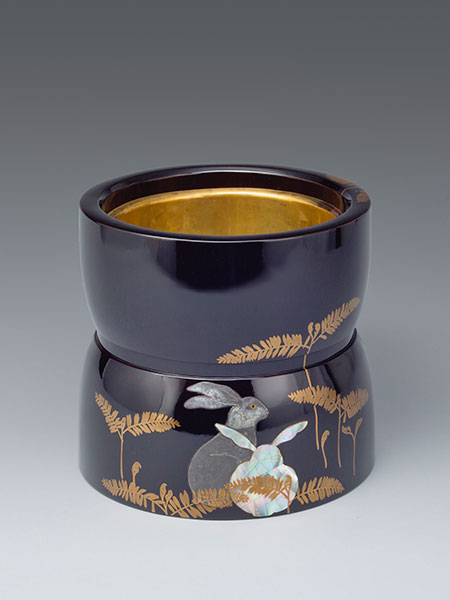 |
| Suzuki Hyōsaku I (Suzuki Sutekichi), 1874–1943, Pair of Hand-Warmers (teaburi) with Rabbits and Ferns. Kyoto; Taishō period, about 1912–26. Lacquer, mother-of-pearl, lead, gilt-copper. Denver Art Museum; Sam F. and Freda Davis Charitable Trust, 2011.285.1–.2. (Photo courtesy Denver Art Museum; click to enlarge) |
The center of the exhibition space is devoted to explaining the craft of lacquer, the refined oleoresin from trees, originally obtained from the “one hundred thousand” (Sanskrit: laksha) Lac insects that secrete their own resins. The lacquer, to which various pigments can be added, dries very hard, having been applied in layer after layer in a process that is specialized and time-consuming. Thus, many lacquer objects exhibit a lovely balance between lacquer’s durability and rigidity, and the delicate detail of figurative decoration. And then there are objects that, mm, break such typecasting, such as the tray pictured below.
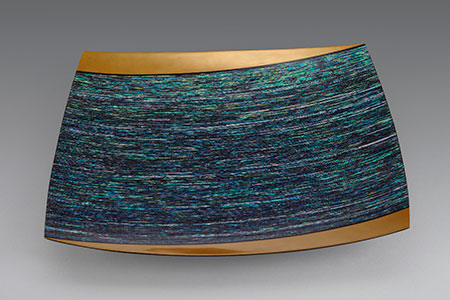 |
| Okada Yūji, born 1948, Tray “Sound of Wind.” Kyoto; Heisei period, 2004. Lacquer, mother-of-pearl. Denver Art Museum; John & Carson Taylor, Wann Caron, Ronald Otsuka, and Asian Art Association members in honor of the Asian Art Association’s 30th anniversary, 2011.349. (Photo courtesy Denver Art Museum) |
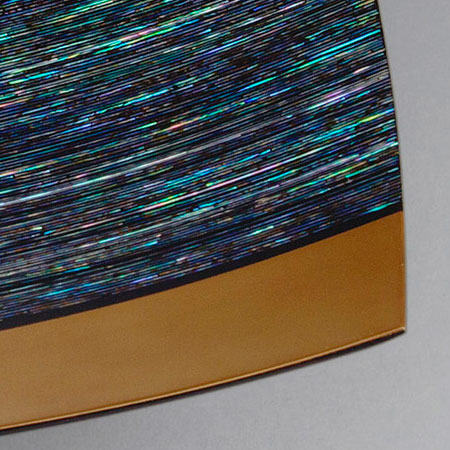 |
Curator Ronald Otsuka will lead a tour of the exhibit on Friday, February 1. The exhibition is up until October 5, 2014. [back to top]
This month we feature a gem usually found on the mineral side of the business. Amazonite feldspar is found in many pegmatites around the globe, ideally showing beautiful prismatic bluish-green crystals. These amazonite crystals are almost always milky and opaque, but occasionally you find clean enough sections to facet. Amazonite is a gemological term that can apply to green and bluish-green feldspars. As a gemological term amazonite has been applied to green feldspars (both microcline and orthoclase) recognized since the early 1900s (Bauer: Precious stones..., 1904, L. J. Spencer translation).
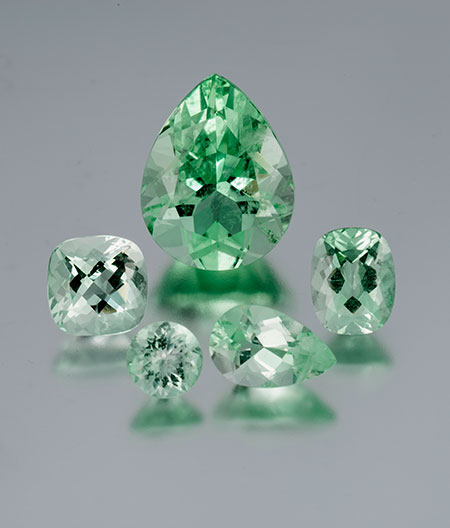 |
| Amazonite feldspar suite: above, 12.19-carat pear shape, 18 x 14 x 10 mm; below, left to right, 2.79-carat cushion, 0.97-carat round, 2.17-carat pear shape, 2.22-carat cushion. (Photo: Mia Dixon) |
Pala acquired a rough parcel of some of these exceptional amazonites, and had them tested by Prof. George Rossman up at Caltech to make sure they were 100% natural. These gems were cut from a parcel that can be traced back to a gem pocket in Luc Yen, Vietnam. This pocket was uncovered in 1997 and contained many high quality tourmaline crystals along with some of these gemmy amazonite feldspars. The color is reminiscent of neon-green paraiba tourmaline, showing fluorescent-like properties in daylight. This is fairly common mineral transformed into extremely rare and beautiful faceted gems.
Interested? Call (phone numbers below) or email us to inquire. [back to top]
Just before Christmas, Pala staffer Jason Stephenson accompanied mine foreman John McLean to the Esmeralda Mine, Jason not having visited the mine since the late summer of 2011. In his new blog entry, Jason show-and-tells about the improvements to the mine infrastructure. And the mine had a couple of other visitors…
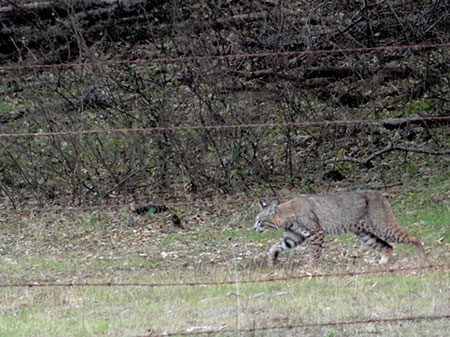 |
[back to top]
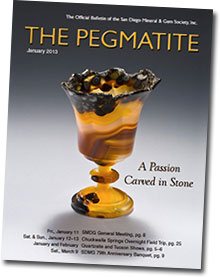 |
Along with his wife, Erica, Harold Van Pelt is best known as a photographer of fine gemstones and mineral specimens. Recent exposure has shone a light on Harold’s other area of artistry. If an exhibition of his gemstone carvings at Southern California’s Bowers Museum—currently at the Houston Museum of Natural Science—left any viewers hungry for more, this month’s The Pegmatite, the bulletin of the San Diego Gem & Mineral Society, provides.
In “A Private Passion Carved in Stone,” Pegmatite editor Lisbet Thoresen chronicles the very limited publicity that has been given to Van Pelt’s lapidary work, including mentions by the late John Sinkankas, himself a master carver. It was Sinkankas who taught Van Pelt—virtually—his craft and art. Intrigued?
You’ll also want to see the master’s most recent work, unpublished until now on page 15, the carving of a foot in rutilated quartz—prickly, sparkler-y, superb. It will be exhibited at this year’s Tucson Gem and Mineral Show.
You can obtain the print version here. [back to top]
Retired engineer Harold Killingback came late to gemology, receiving his FGA in 2002 from The Gemmological Association of Great Britain (Gem-A) at the age of 77. His work has been published in the pages of Gem-A’s Gems and Jewellery and The Journal of Gemmology. The former publication features an article not on asterism, a subject of which Killingback is fond, but on microscope lighting.
In a letter to Elise Skalwold, Killingback describes his system:
I have made a device for lighting specimens on my gemmological microscope. It consists of twelve high-intensity white LEDs clamped in a circle between a steel washer and a transparent plastic base. The latter carries guides so that the centre of the washer is constrained to coincide with the optic axis of the microscope. A lead is taken from each LED to a 12-pole rotary switch (see the wires with red insulating sleeves in the photo). The switch is mounted on a control panel, under which is a battery and a holder for a current limiting resistor.
The specimen can be viewed with side light from any angle, from 1 o’clock to 12 o’clock, without changing its position, a great help when studying the topography of an inclusion. This method is intended as additional to the normal bright field, dark field and top lighting, not as an alternative.
The idea is more fully described in “Making Light Work,” Gems & Jewellery, Winter 2012, Vol. 21, No. 4.
More information about Gems & Jewellery is available here.
Also in the pages of the current Gems & Jewellery, page 48 to be exact:
In his “Stone Scoop” column, Jack Ogden reported on a 2012 Gem-A board meeting at which the members spent quite some time in negotiation on whether the redundant “m” in the British spelling of “gemmology” might not be dropped. (Just today, while composing the above story on microscope lighting, we caught ourselves dropping in a third “m” for good measure.) It seems that protracted debate centered (or is that centred?) on just which of the two “m”s might be given the heave-ho. The final decision? You’ll just have to ask a Gem-A member.
Alas, what waits in store for “jewellery”? [back to top]
Edward Swoboda, 95 years young!
A “renaissance man,” Ed Swoboda grew up loving gems and minerals: digging in the benitoite mine in the 1930s with Pete Bancroft, moving on to Brazil before the Second World War to look for rare earth elements for the United States Geological Survey and collecting rare bird and other species in the Mato Grosso jungle regions, as well opening a successful hamburger restaurant on the Copacabana in Rio! Later, after returning to the U.S., he became a successful jewelry designer and entrepreneur. He went early on to east Africa in pursuit of Longido ruby (see Ed’s article on the subject on Palagems.com). So when I met Ed in 1968, to me he was a “mineral god.”
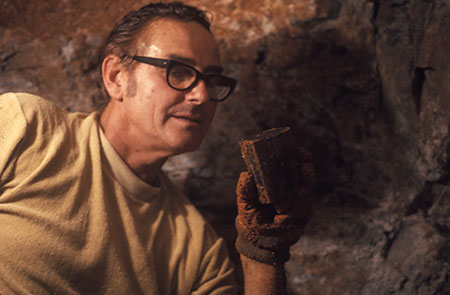 |
| Edward Swoboda with a new find at the Tourmaline Queen Mine, 1971. |
Our first encounter was at the county fair in Del Mar where he was judging the mineral display, and while he gave me first place on several of my self-collected pieces, he downgraded my thumbnails, instead opting for the display of a friend of his, who I had beaten for the past three years. So I proceeded to ask him why he judged my thumbnails less than those of his friend, Elbert McMacken. We laughed. His real interest was to find out more about my self-collected pieces. (Had he snubbed me in order to do so?) I explained that I had been drafted into the military out of graduate school, and for the past three months Josie Scripps and I had done three mining projects—the Little Three Mine (Ramona, San Diego Co.), the Blue Chihuahua Mine (Cooper Canyon, Riverside Co.) and the Mack Mine (Rincon, San Diego Co.)—and we had been successful in each one of them.
He invited me up to his home and asked me to bring the finest herderite I had found. We did an exchange for three of his best thumbnails. He asked if I would be interested in creating a mineral company to travel the world and buy and try to mine minerals. Of course I was interested. He had recently purchased the Stewart Lithia Mine in Pala, California. I had extensive knowledge from self-collecting in Pala, and my father knew Monty Moore who owned the Tourmaline Queen and Pala Chief mines, so we arranged a lease buyout of these two properties and created a company called Pala Properties International. Thanks in part to Terry Szenics, the Stewart Mine produced tourmaline in the first six months of operation.
When I got out of the military in 1970, the mine was providing a small production, but it was too small to afford much expansion, so we planned a buying trip. Josie Scripps loaned Pala $10,000 for the trip. And Ed planned it—a major undertaking. I got to know Ed quite well on this first trip in 1971. We went to Idar-Oberstein, Germany, meeting Gerhardt Becker and Dr. Herman Bank; to Spain to see the Folch Collection; down to Angola, looking for dioptase, where I found, instead, amoebic dysentery from eating crab that was less than fresh. Ed’s system was tough, so he missed my joy. We flew across Africa to Mozambique where we went north to Nacala and Nampula. Here we had the most profitable venture, at the Agria Mine, where we bought 4 kg of flawless, unusually-colored tourmalines for $1400. Then we flew to Johannesburg and met the famous collector Jerry Rousseau and viewed his collection. Ed was very taken with Jerry’s self-collected large matrix sperrylite. Edward would later ask me to come back to Africa within six months and exchange Jerry out of said sperrylite, which at the time was the finest in private hands. It became a highlight of Ed’s great collection.
The trip continued across the oceans to Rio de Janeiro where I got to meet and see some of Ed’s old friends and neighborhood. The high point for me was meeting Antônio Carlos Jobim (“The Girl from Ipanema”), who came and sat next to me as we had Fernet-Branca in the bar at the Copacabana Palace Hotel. Wow! The next day it was a drive upcountry where we came around a curve and saw elephants running free. We were amazed until, further around the curve, we saw the overturned circus truck. The rest of the trip, into Minas Gerais, was busy as we visited famous mines (like the Santa Rosa tourmaline mine) and various dealers. The biggest purchase we were able to make was about two tons of large quartz crystals from one dealer that we shipped by sea. It included the famous crystal that Harold Van Pelt carved his magnificent skull from very recently. (The crystal, originally weighing 250+ lbs., contains rare izoklakeite inclusions.)
We left Brazil and headed for Chile; we were looking for proustites! We did find one magnificent crystal in a vault, perhaps 3 x 2 inches, but it was part of the mineral collection of the University of Santiago! I presume it’s still there since I’ve never seen or heard of it. So we were commercially unsuccessful in Chile and flew to Bogotá, Colombia where Ed and I saw the magnificent gold museum. We visited several emerald dealers and we picked up an incredible single gem emerald crystal, two inches by just under a quarter inch.
We flew back to LAX a bit exhausted after 3+ weeks of intense travel. This set the stage for many other trips and mining adventures, the highlight of which for Pala Properties would come later, in 1972, when John McLean found the famous blue-cap tourmaline pocket at the Tourmaline Queen Mine.
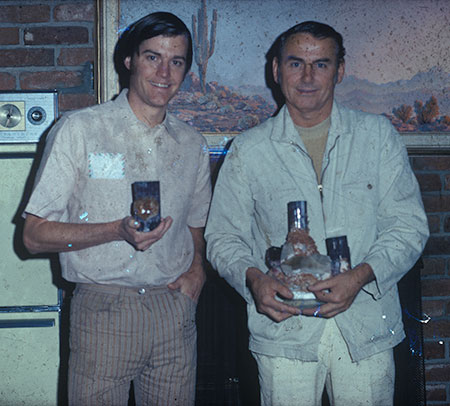 |
| Edward Swoboda, right, with Bill Larson in 1972, holding two of the famous blue-cap tourmaline specimens, in a slide that looks like it had been left in an outbuilding at the Tourmaline Queen. See last month’s Pala Mineralis, which points to a reprint of Bill’s 1972 Lapidary Journal article about the original blue-cap finds. |
In 1978 Ed really wanted to go mine in Brazil and I really wanted to go mine in Sri Lanka. It was time to move in new directions. To be able to purchase Ed’s 50% of the corporation, Ed took ownership of the mines we owned, I took the Himalaya Mine that we leased and the corporation became Pala International. The parting was, shall we say, not without a little acrimony.
After going our separate ways for over a decade, in the 1990s we met again in a setting where we were able to talk. He found out I’d lost all the money I’d invested in Sri Lanka and he mentioned that he lost all the money he invested in Brazil! After a great, long laugh I think we both forgot the rancor of the business split. For the past 15 years we’ve had quite a good relationship, including getting to know Ed’s son Bryan so well. (Bryan, and his BlueCap Productions, has done more good for the mineral hobby than perhaps any other individual in the past decade!)
It is with great fondness that I look back over Ed’s amazing life!
Edward Roy Swoboda, born November 30, 1917, died January 7, 2013. He is survived by his wife, Kum Ja, his son, Bryan, his daughter, Sumiya, and grandchildren.
[back to top]
A little bird told us that Richard Russell, of Dow Theory Letters, in a January 4 missive, wrote something along these lines: Sophisticated capital has a tendency to lead markets, not follow them. Russell hears that big money is putting its cash into objects—the rare, the unique. That includes gem quality colored gemstones commanding prices that astonish most experts.
In the last couple of days, Harry Winston Diamond Corporation has announced that it has “lost” its luxury brand segment on the one hand, and gained in its Canadian diamond production on the other. In its January 14 press release, the company announced that its luxury brand diamond jewelry and timepiece division, Harry Winston Inc., was being sold to The Swatch Group Ltd. for $750 million (and assumption of debt). Chairman and CEO Robert Gannicott explained:
At the time that we purchased the Harry Winston brand, resource investment opportunities for diamonds were rare and expensive following the euphoria of the Canadian diamond discoveries, and the involvement of the large international mining companies. The Harry Winston brand was competitively priced compared with its peers and we could bring diamond expertise and strategic connections to enhance value. Today there is a range of diamond resource opportunities while the value of heritage luxury brands has increased dramatically. This transaction represents a sound return on our original investment. It will leave us well equipped to realize upstream opportunities in an environment where cash has become a strategic resource while preserving and expanding our relationship with the downstream diamond business.
 |
| Diavik Diamond Mine, aerial view, in Canada’s Northwest Territories. Click to enlarge. (Photo courtesy of The Diavik Diamond Mine) |
The Harry Winston Diamond Corporation will continue to supply Swatch with diamonds but will trade under a new name, Dominion Diamond Corporation. On January 15, the Corporation announced that the Diavik Diamond Mine (in which it holds 40% interest) realized a 16% increase in carats produced during the last quarter of 2012. For calendar year 2012, the increase was 7%.
News Item: New Delhi, April 29, 2012. An Indian espionage agency keeping tabs on terrorism modules operating from Pakistan is nowadays “eyeing” Kashmir’s world-famous blue sapphires. (The Tribune)
An Associated Press article last weekend, dealing with the perennial conflict in Kashmir between Pakistan and India, stated that the countries are seeking to “ease tension” in their relations. While local press has fanned flames regarding the situation in Kashmir, even Islamic hardliners who oppose a softening in relations have been “muted” in their response, according to the report. Why? “Pakistan desperately wants increased trade with India to help turn around its stuttering economy.” Ditto for India.
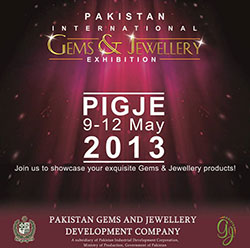 |
Pakistan’s gem and jewelry players already understand the importance of such cross-border relations. For some time, the Pakistan Gems and Jewellery Development Company (PGJDC), which will have a presence at the Tucson show again this year, has participated in the Indian International Jewellery Shows in Mumbai and Goa. An undated (2011) PGJDC newsletter talked of setting up a gems and jewelry training a processing center in Azad Jammu and Kashmir but the trade organization’s newly revamped website lists only five other such centers. This month, PGJDC announced the Pakistan International Gems & Jewellery Exhibition, to be held May 9–12, 2013, in Karachi’s Pearl Continental Hotel.
The PGJDC website contains some statistics. For the first nine months of a fiscal year 2011–12 (Jul–Mar), gems and jewelry had a 109.57% increase over the same period the year before. For that same period, gem export value dropped by 15%, while jewelry export value increased by nearly 111%. [back to top]
 |
| Music from Little Pink. This 3.32-carat spinel from Burma will bring music to someone’s eyes this Valentine’s Day. Inv. #20761. (Photo: Mia Dixon) |
Today, The Irrawaddy reported that Burma’s president Thein Sein has repealed a law that in the past was used to jail dissidents for criticizing the government. This comes at the same time that the government is being faulted for an artillery attack on a border town in Kachin near the headquarters of the Kachin Independence Army (KIA). Hostilities between Burma’s army and KIA has caused the displacement of miners in Jade Land since a cease-fire fell apart 18 months ago. The clash has caused China to make noises about taking “measures to protect its frontier,” according to The Washington Post last Sunday.
The formerly jailed Aung San Suu Kyi is herself under attack for a relative silence on ethnic issues—she finally called for an end to fighting in Kachin in an Irrawaddy interview yesterday—as well as for her National League for Democracy receiving monetary support from military-era jade-mining interests.
Indeed, the Kachin conflict seems to have contributed to the dearth of large-scale gem sales in the last nine months. Into that void, it was announced early this month, enters a government plan to open a “gem industry hub,” as The Irrawaddy put it, in the political capital of Nay Pyi Taw. The plan calls for “91 plots for jade stores and jade industries” that would go for $375,000 a pop; 19 smaller plots would be sold for $263,000 apiece. The door appears to be ajar for foreign involvement. The story quotes a local gem dealer as saying that a previous attempt at such a venture failed—due to the lack of up-to-date technology needed for gemstone processing and creation of value-added products.
Another industry-related effort was announced in mid-December: compliance with the Extractive Industry Transparency Initiative, a global standard that promotes revenue transparency, i.e., “monitoring and reconciling company payments and government revenues at the country level.” Later in the month, environmentalists themselves called for transparency in the course of natural resource exploitation, including gemstones.
Meanwhile, a court battle continues over millions of dollars’ worth of jade that apparently were extracted legally in Hpakant in 2006, but were sent to China without proper documentation, according to Eleven Media Group on December 24. [back to top]
In the heart of New York State’s Finger Lakes Region, an emerging artist debuts at the Paleontological Research Institute’s Museum of the Earth
On very still winter nights, the wistful melody of “Far Above Cayuga’s Waters” might be heard faintly from across the fjord-like lake, while high up on its western shore the architecturally magnificent Museum of the Earth glows brightly out of the darkness of the surrounding hills. Under a multitude of bright stars and sparkling, crystalline air, prowling coyotes howl, owls call forlornly and ice crackles. On one such recent evening, scores of people were welcomed in from the biting cold with offerings of wine and hors d’oeuvres for a celebratory opening of works by local photographer Sarah Oros.
Thus begins Elise Skalwold’s profile of Sarah Oros, in the fifth installment of our occasional series, FotogFocus. Read the entire profile here, which includes mention of Sarah’s father, the lapidary artist Mark Oros.
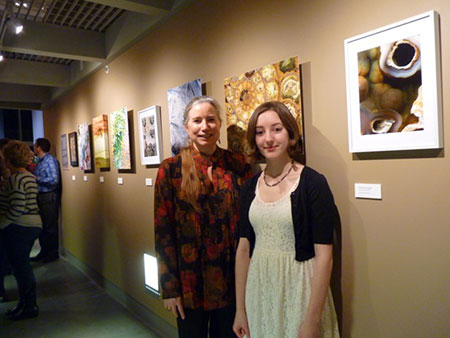 |
| Photographer Sarah Oros, right, with Elise Skalwold, at the opening of Oros’s exhibition, Within Nature’s Design, January 5, 2013, Museum of the Earth. They stand in front of the ammonite fossil, below. (Photo: Mark Oros) |
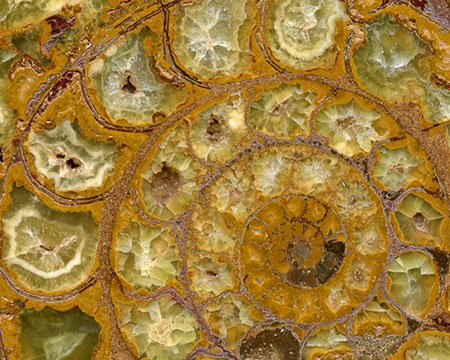 |
| Ammonite Fossil. Polished slice, Madagascar, on white aluminum. (Photo: Sarah Oros) |
[back to top]
— End January Newsletter • Published 1/16/13 —
2015.3 | 2015.2 | 2015.1
2014.3 | 2014.2 | 2014.1 | 2013.3 | 2013.2 | 2013.1 | 2012.3 | 2012.2 | 2012.1
2011.3 | 2011.2 | 2011.1 | 2010.3 | 2010.2 | 2010.1 | 2009.3 | 2009.2 | 2009.1
2008.3 | 2008.2 | 2008.1 | 2007.3 | 2007.2 | 2007.1 | 2006.3 | 2006.2 | 2006.1
2005 | 2004 | 2003 | 2002 | 2001 | 2000
Note: Palagems.com selects much of its material in the interest of fostering a stimulating discourse on the topics of gems, gemology, and the gemstone industry. Therefore the opinions expressed here are not necessarily those held by the proprietors of Palagems.com. We welcome your feedback.